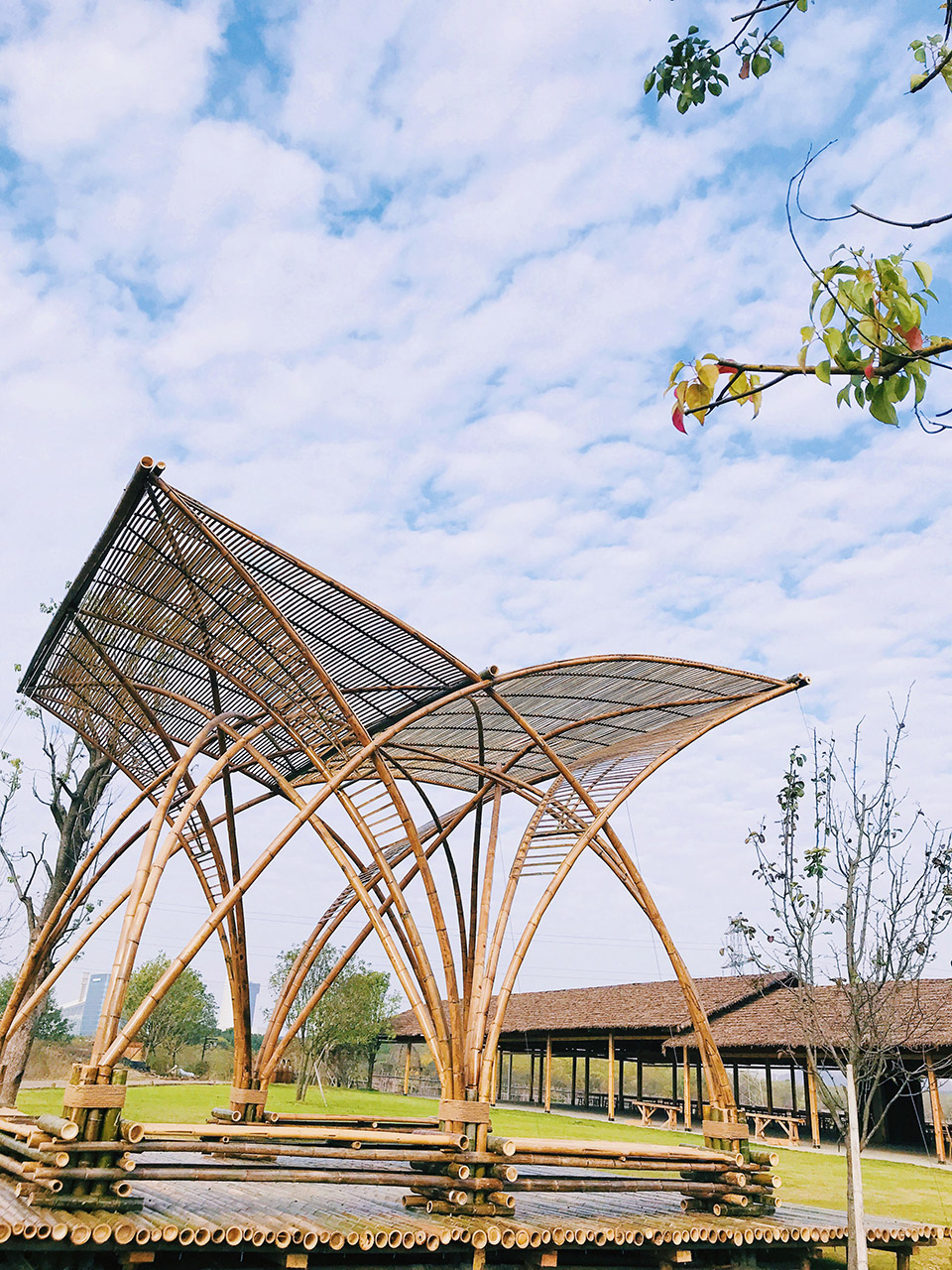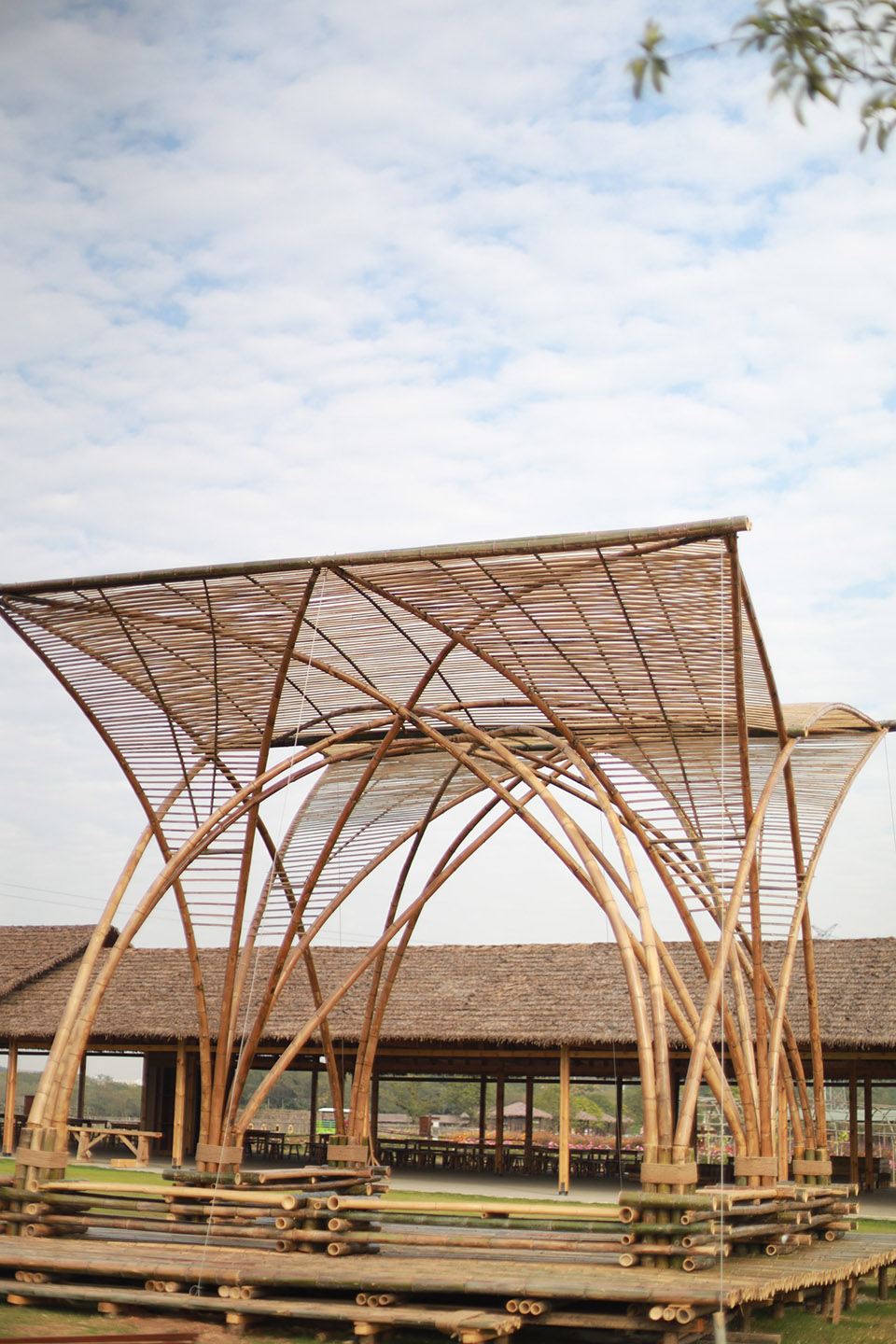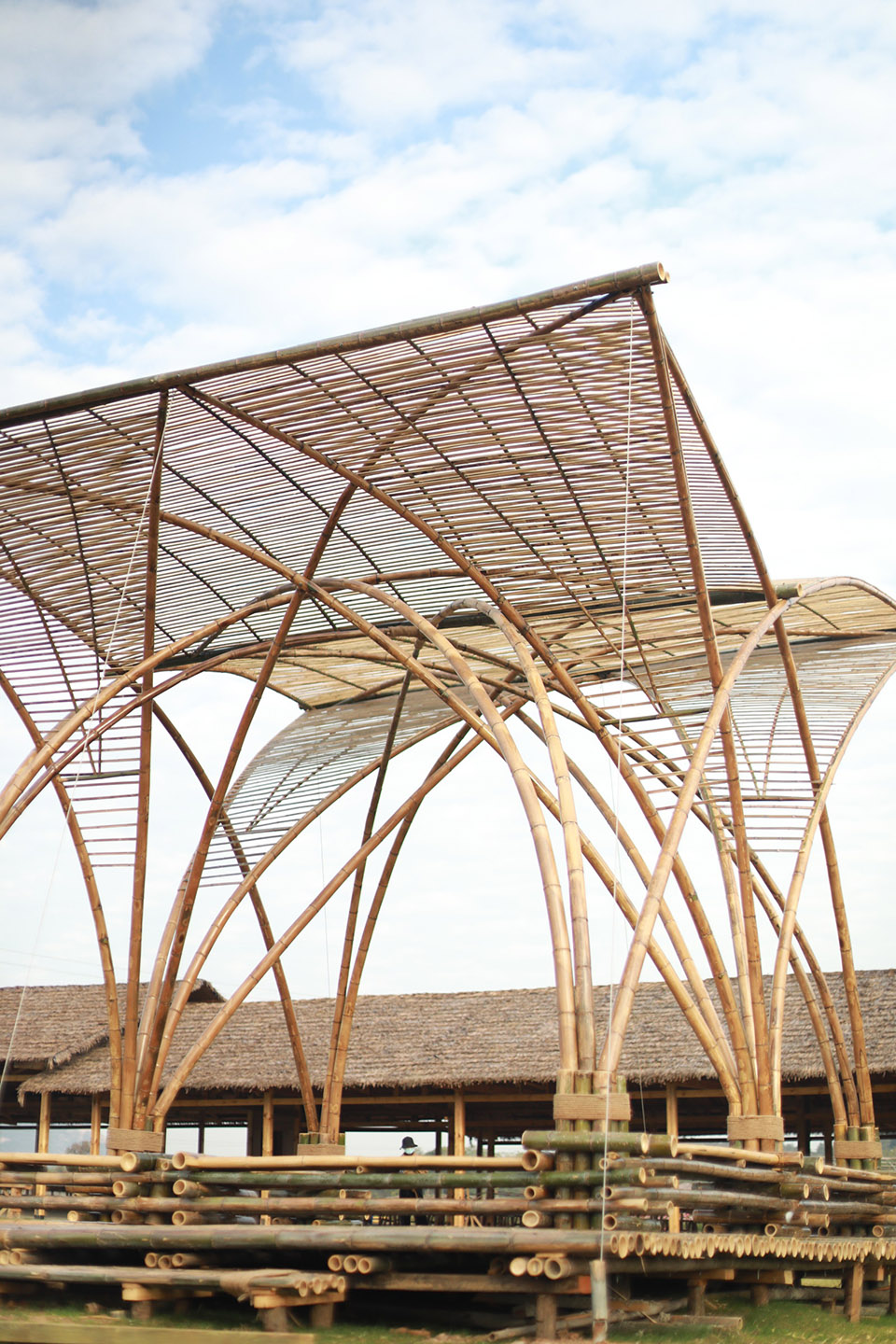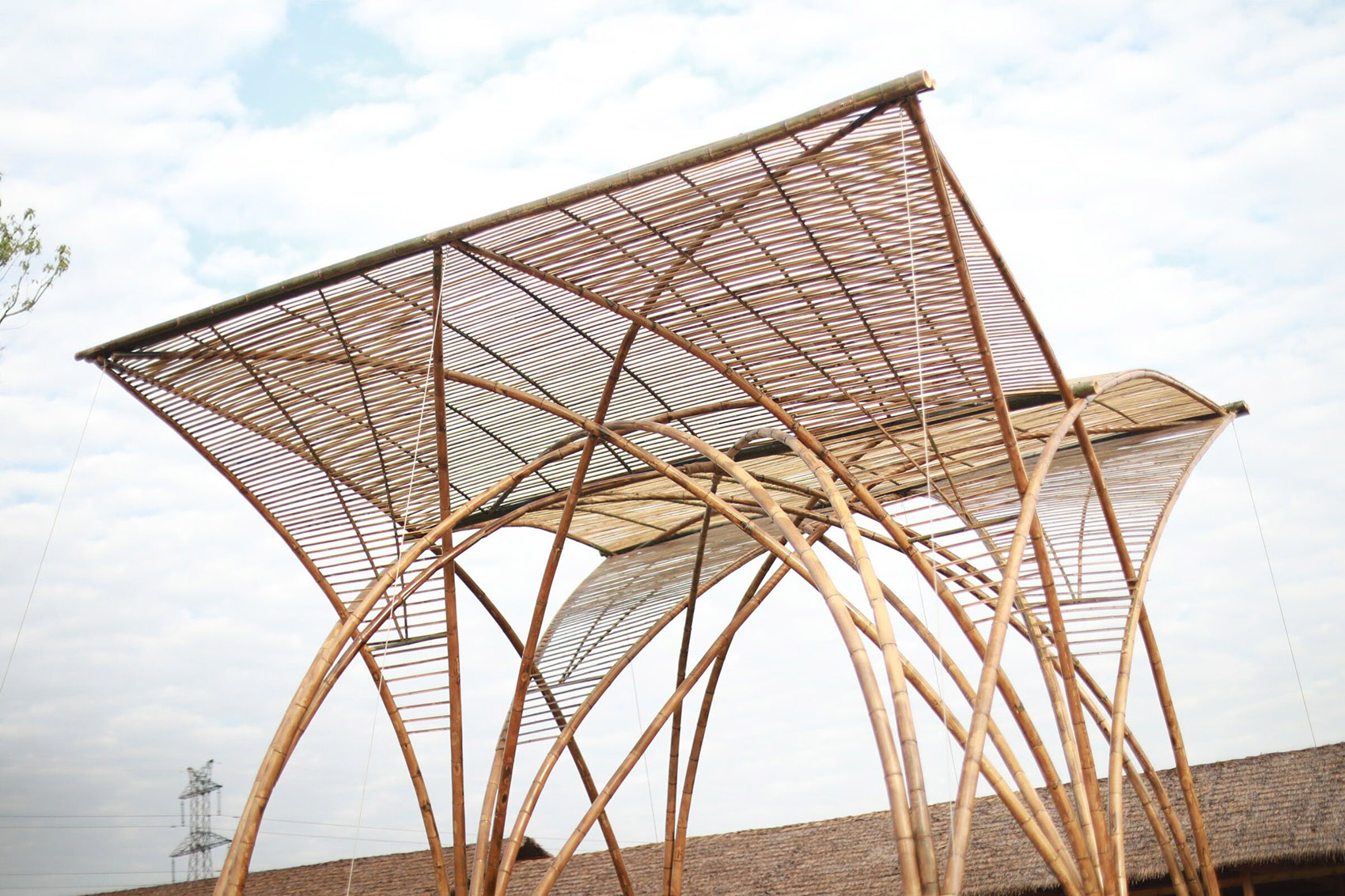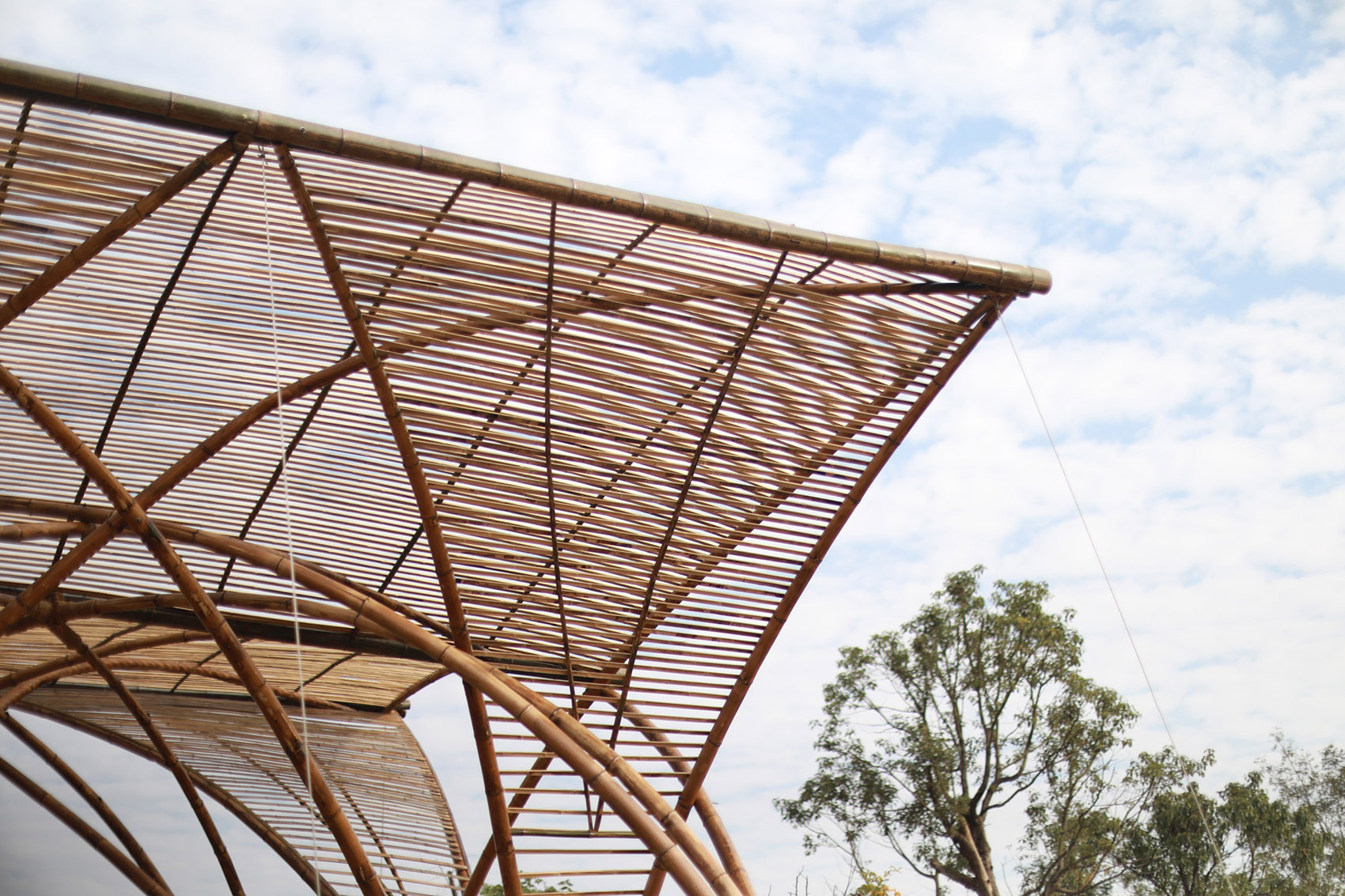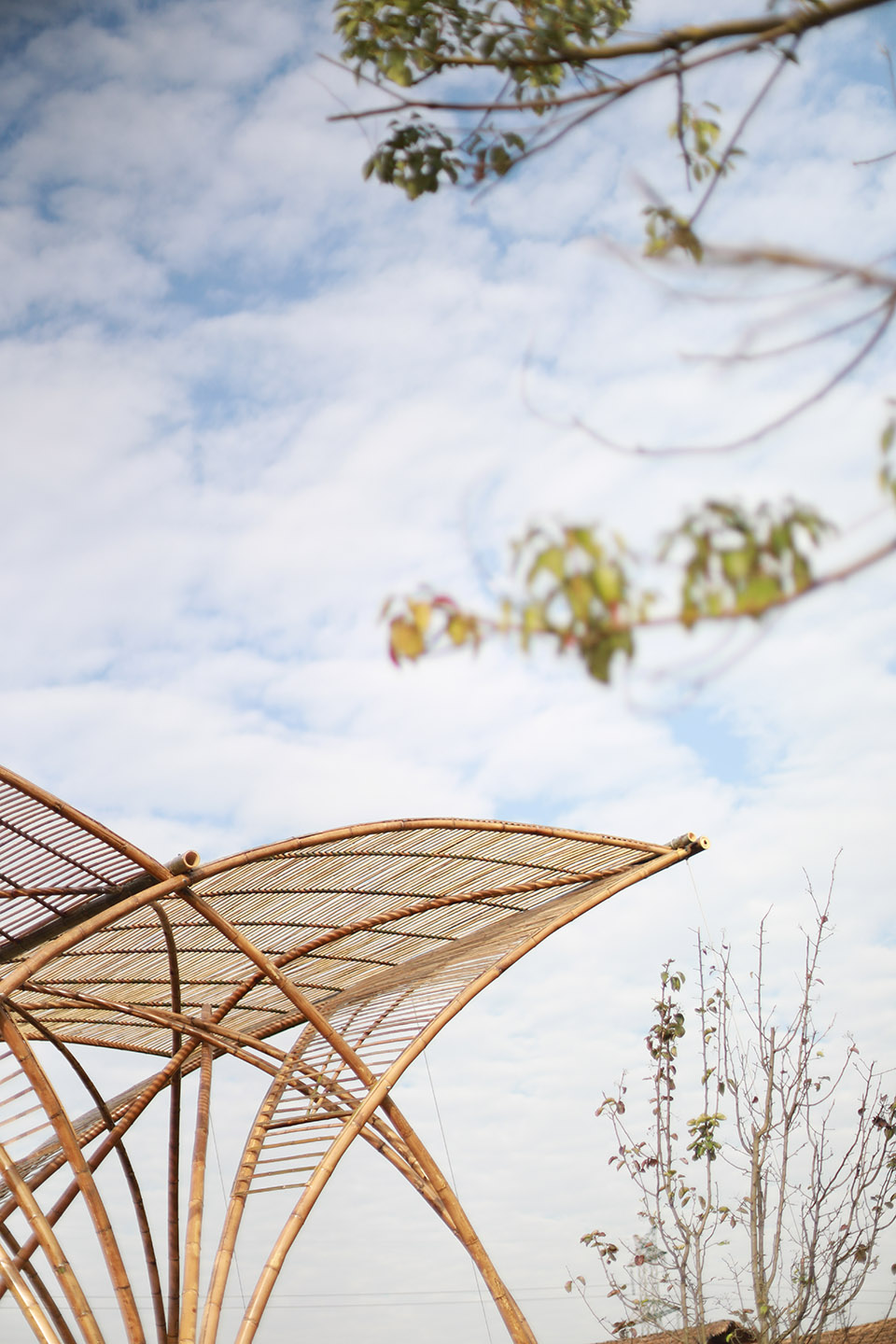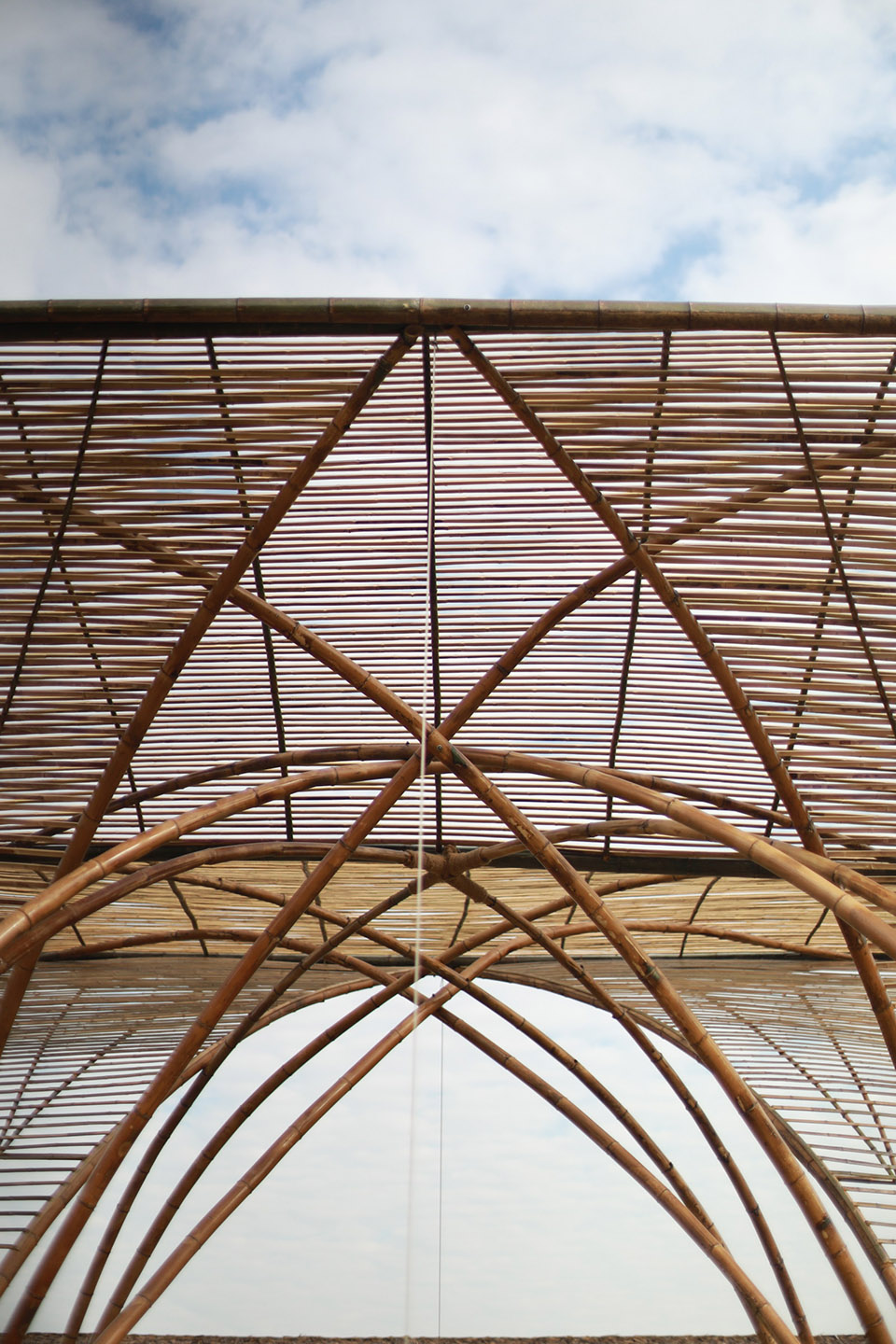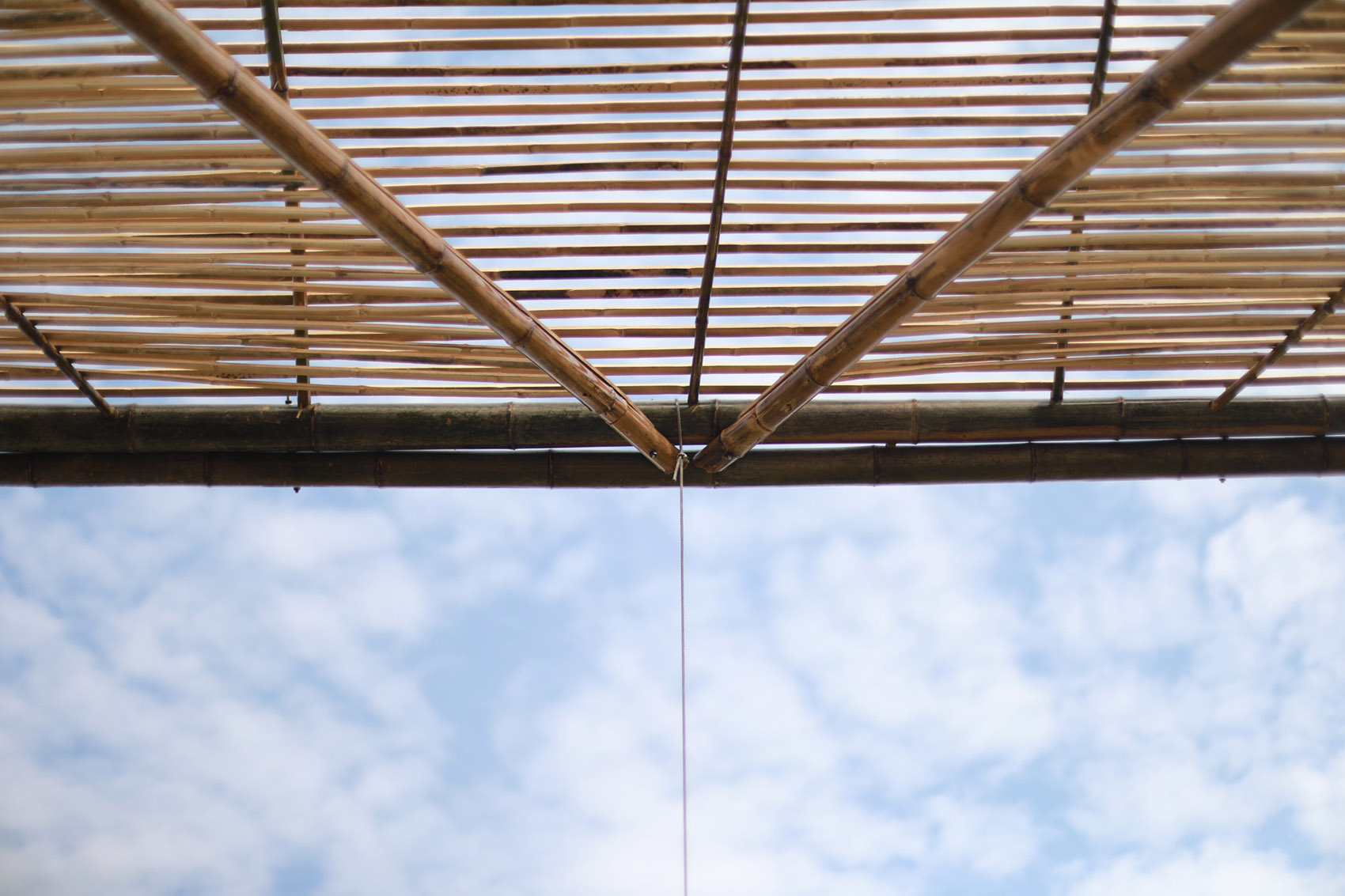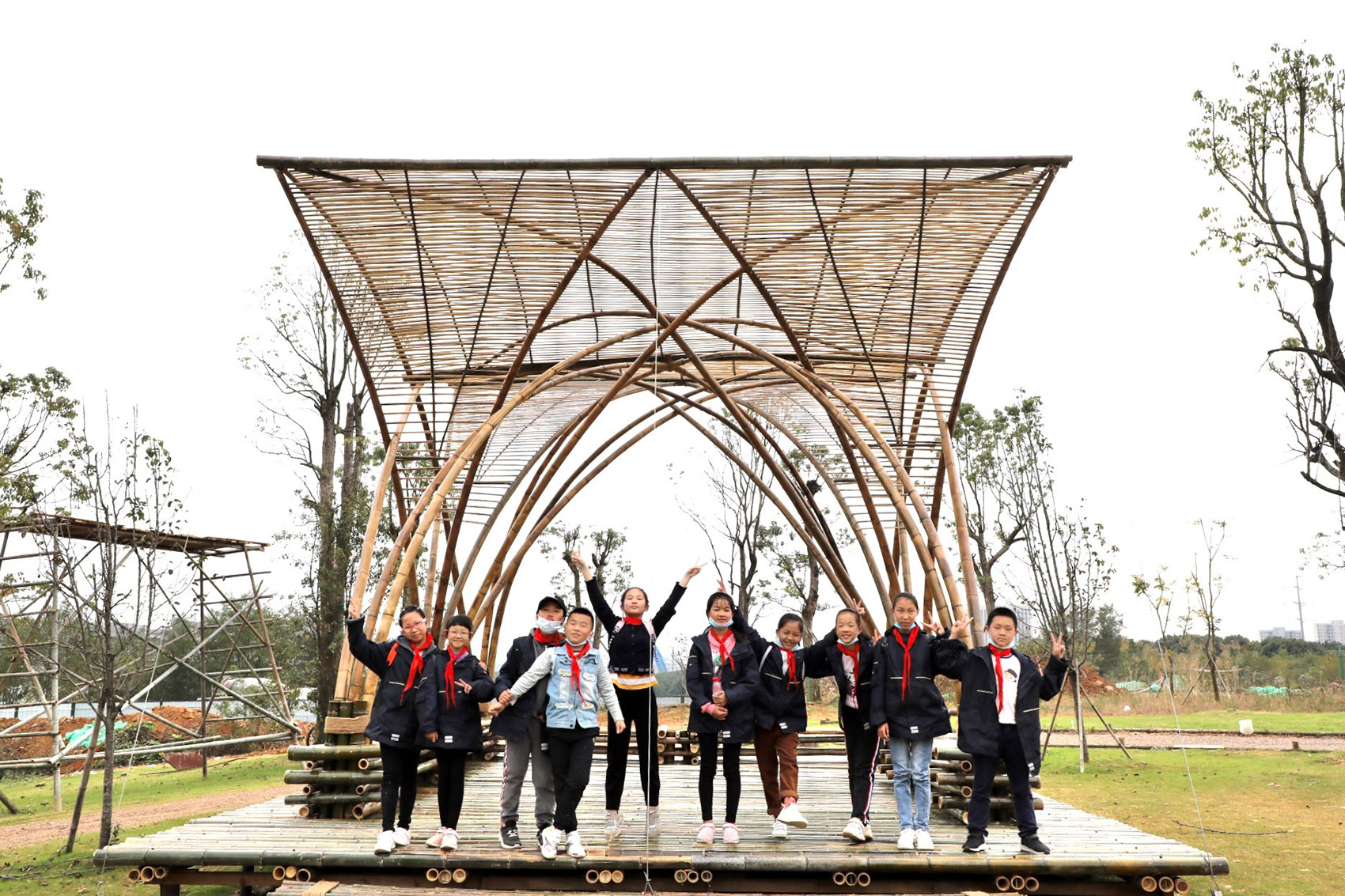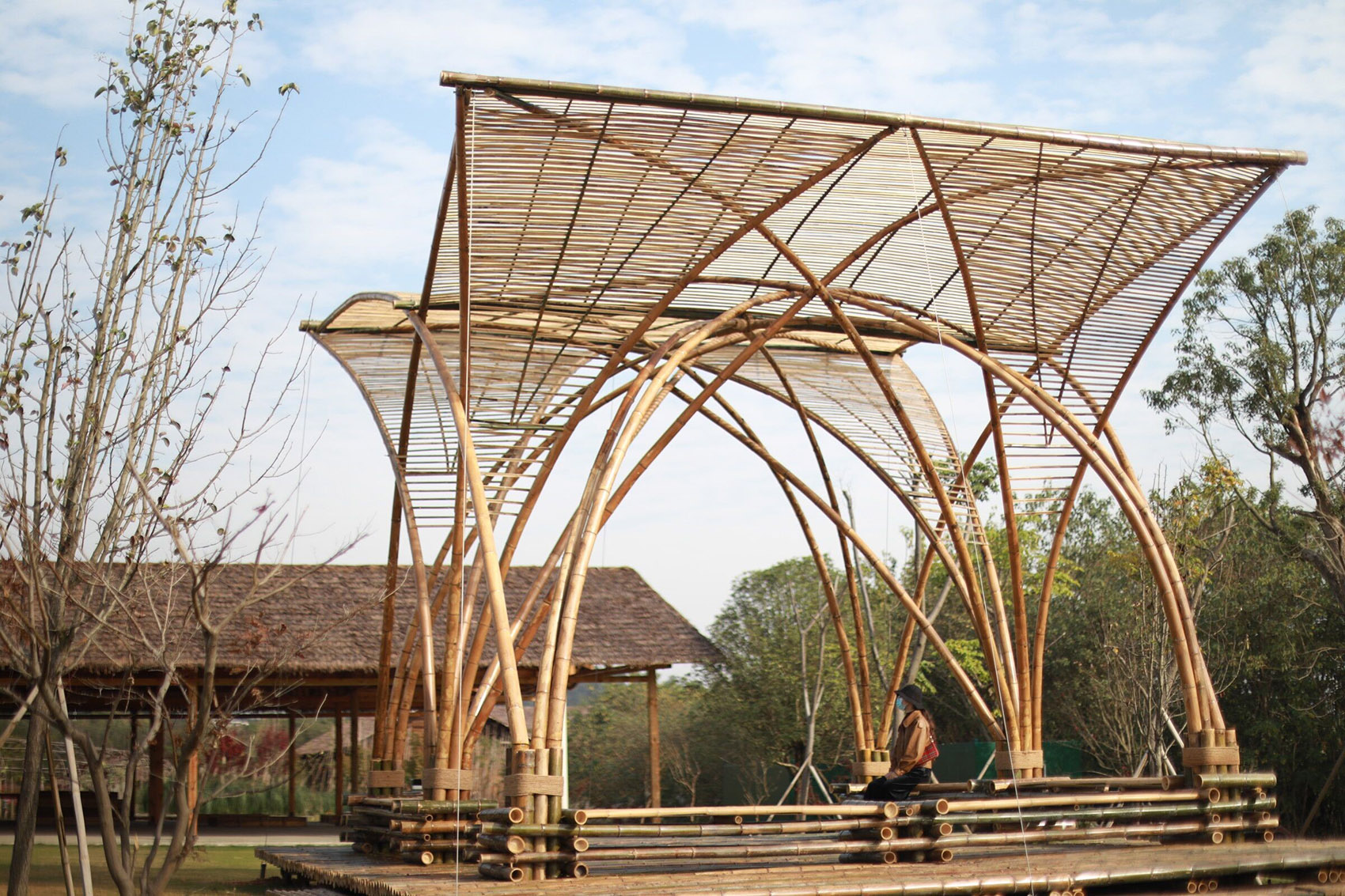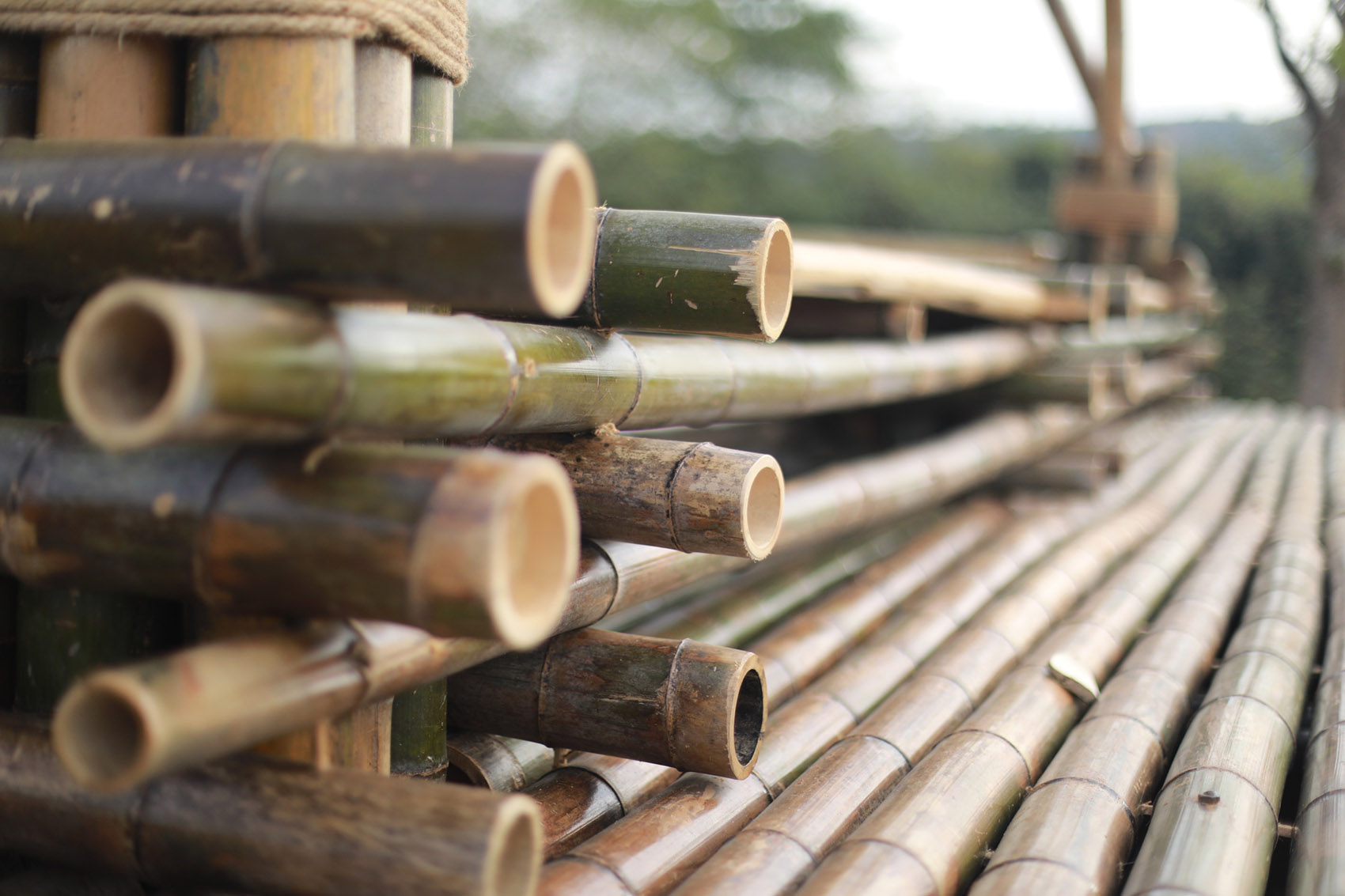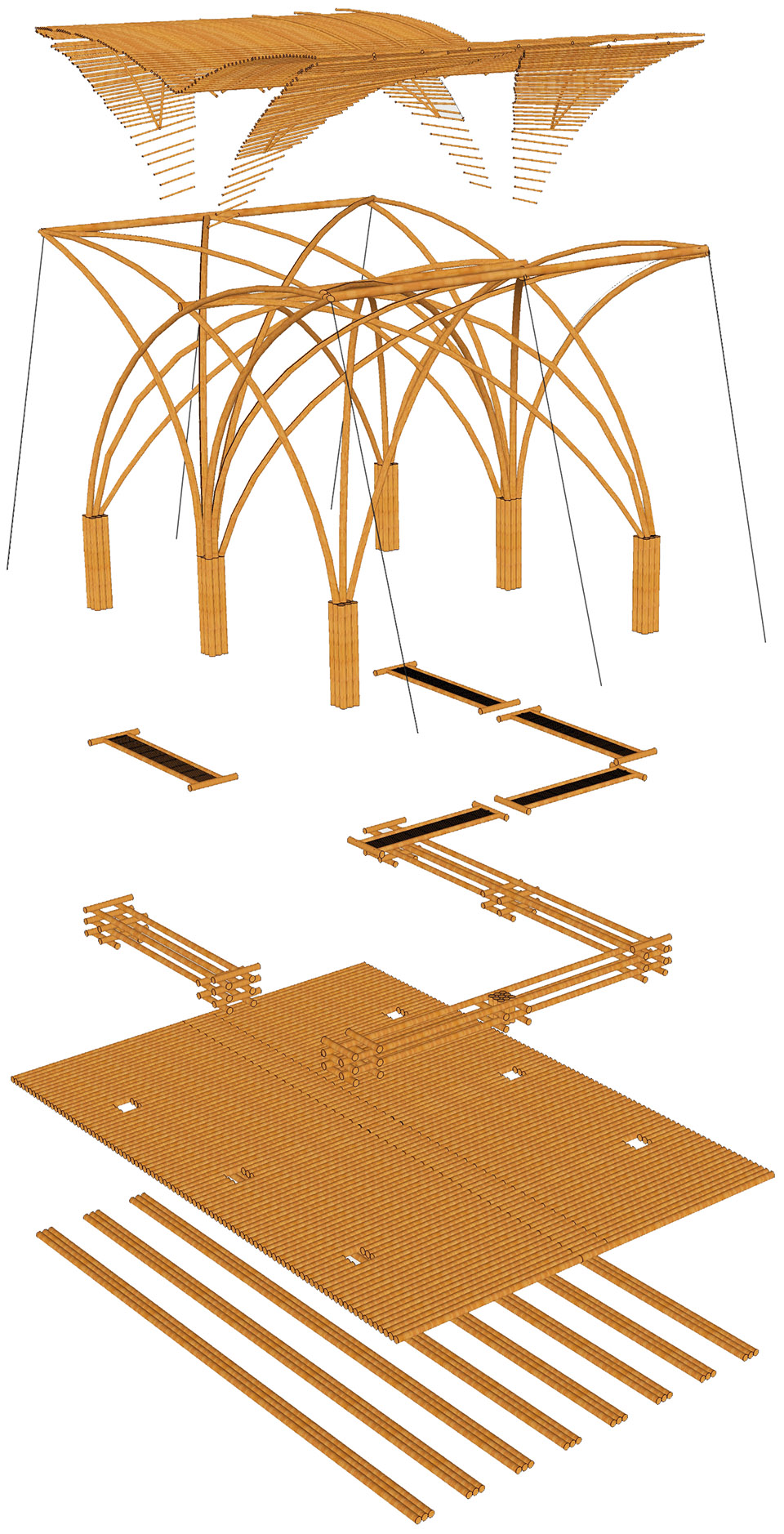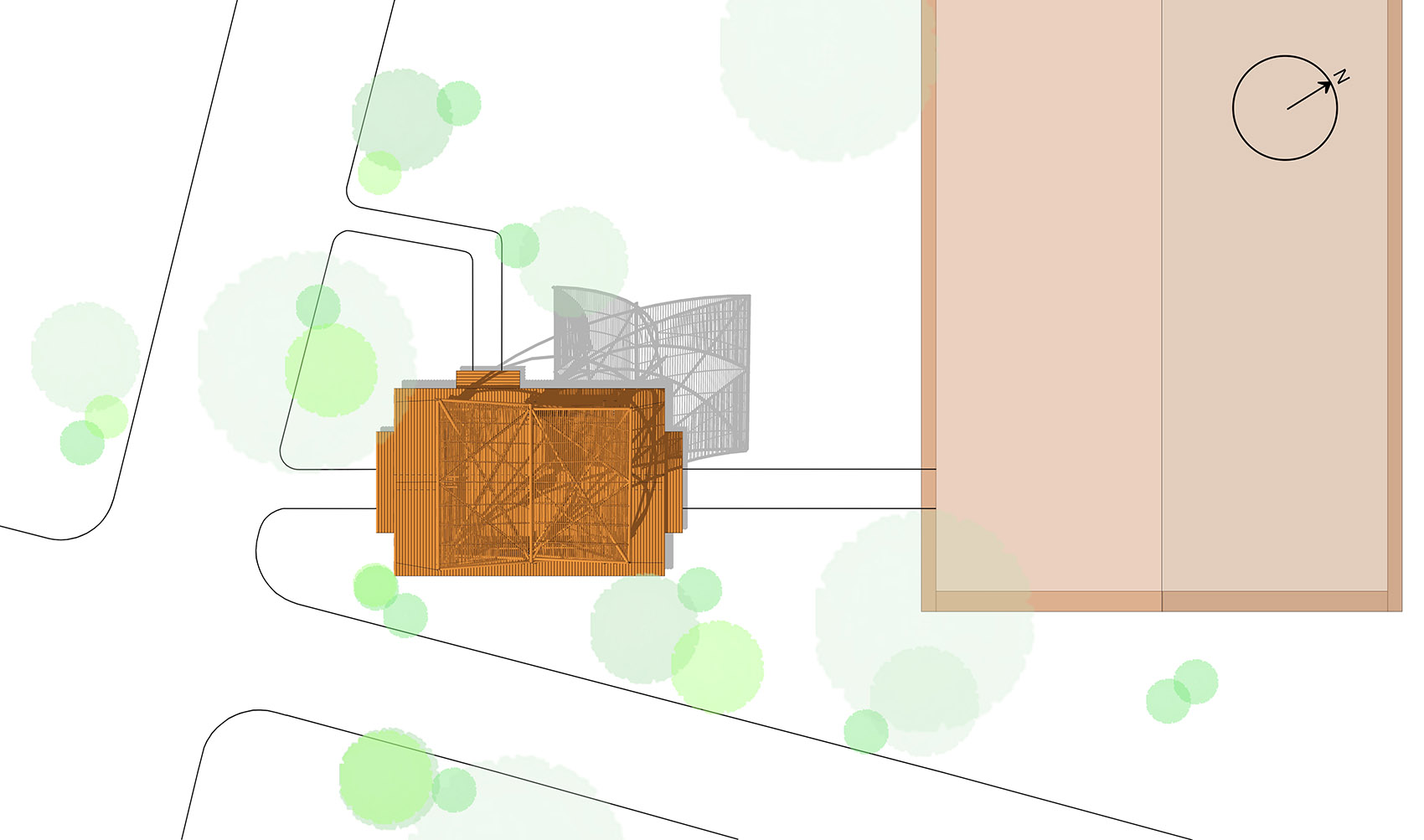凤栖亭位于湖北省武汉市江夏区有田生态田园内。受园区委托设计建造一座凉亭,为游人日常休闲、聚会等提供场所。武汉有田生态园讲究生态理念,提倡在生态领域对公共环境进行修复,本项目使用竹这一自然建造材料,与园区生态理念不谋而合,同时借用这样一个平台来研究学习并传播中国传统竹艺和竹文化,也特别契合。
The project is located in Youtian Ecological Garden in Jiangxia District, Wuhan City, Hubei Province. Entrusted by the park to design and build a pavilion, it will provide a place for tourists to enjoy daily leisure and gathering. Wuhan Youtian Ecological Park pays attention to the ecological concept and advocates the restoration of the public environment in the ecological field. This project uses bamboo as a natural construction material, which coincides with the ecological concept of the park. At the same time, it uses such a platform to study, study and spread traditional Chinese bamboo. Art and bamboo culture are also particularly compatible.
▼竹亭外观,Exterior view ©李杨影
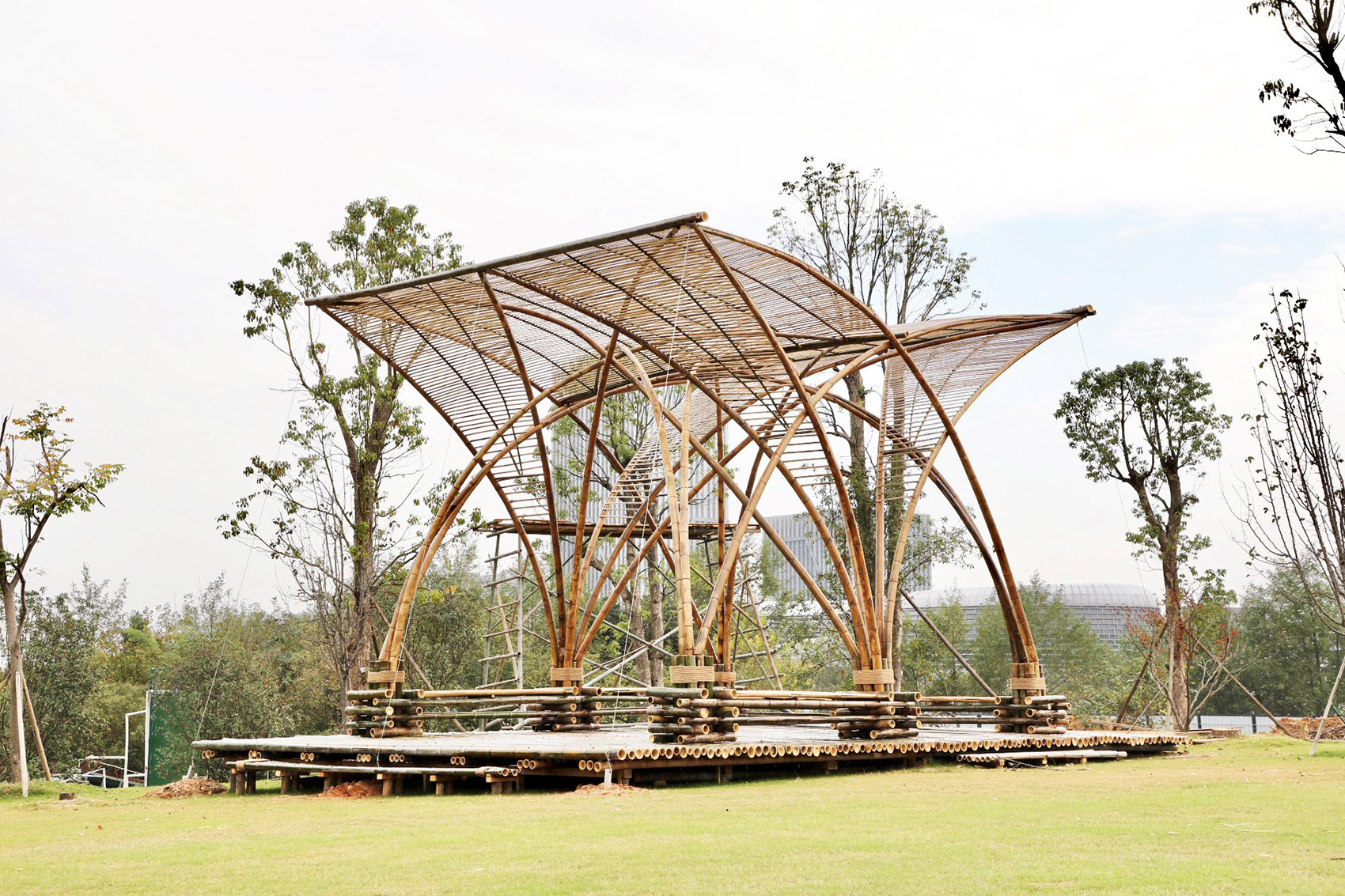

竹构之美,在其形,在其构,在其意;合而为一,得其神。感受竹子质朴古拙的自然之美,以设计之力推动竹建造技艺的发展与革新,积极发现竹子运用的各种可能,在风与声、动与静、有与无、虚与实之间,实现诗意般栖居。
The beauty of bamboo structure lies in its shape, structure, and intention; when they become one, they gain their god. Feel the simple and awkward natural beauty of bamboo, promote the development and innovation of bamboo construction techniques with the power of design, and actively discover the various possibilities of bamboo use, realizing between wind and sound, movement and stillness, existence and absence, virtuality and reality Inhabit like poetry.
▼竹构体现自然之美,Bamboo structure expressing the beauty of nature ©李杨影

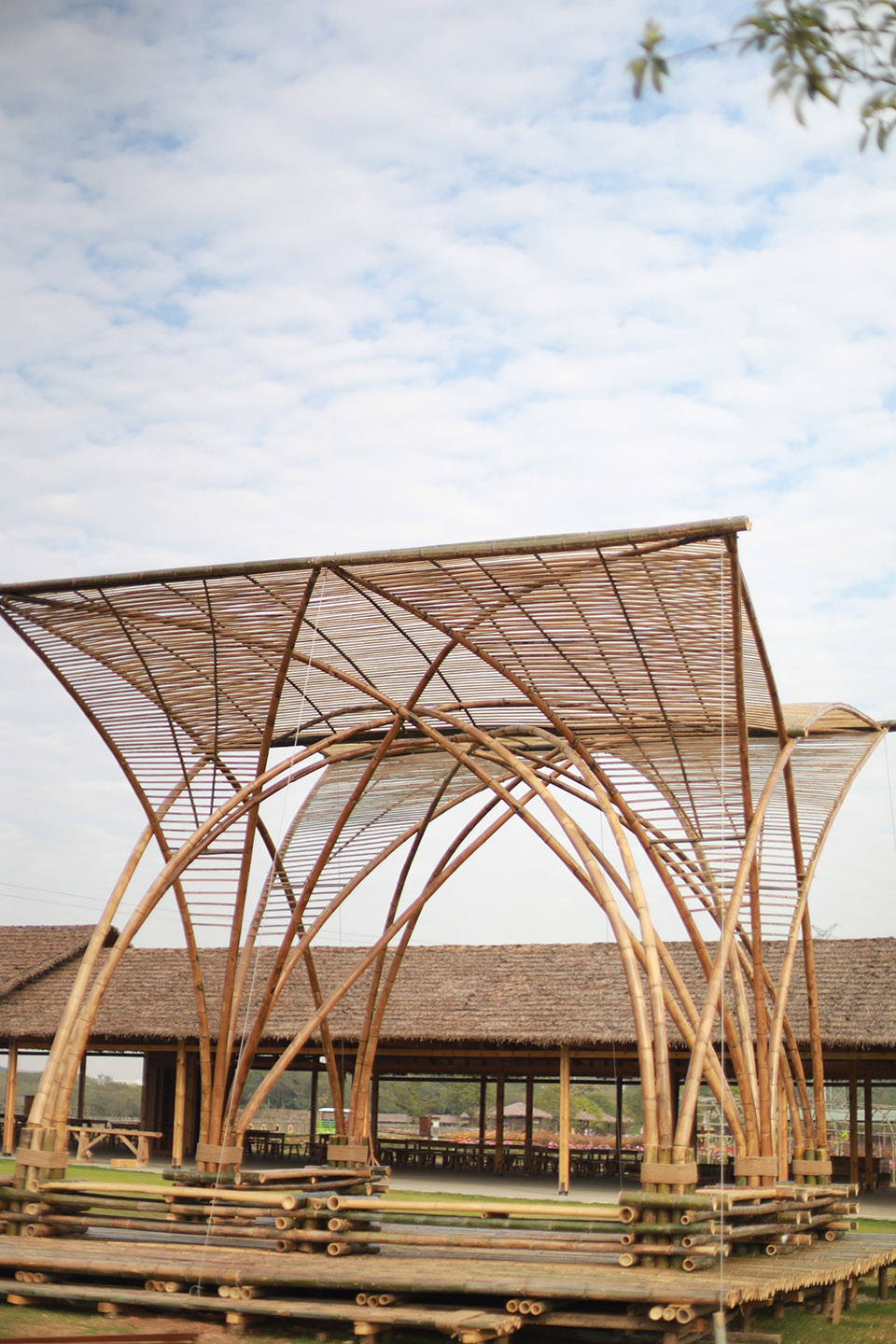
设计灵感来源于《诗经•小雅》中的“如鸟斯革,如翚斯飞”。作品追求轻盈舒展,如鸟张开翅膀,寓意楚地图腾——凤凰,也因此取名为“凤栖亭”;创意上又借鉴了传统天圆地方的思想,拱形穹窿覆盖着四方地面,为设计赋予了更多的东方神韵。设计采用了现代的结构理念与构造技术,将古典形象与现代技艺巧妙融合。在现代感和古典建筑神韵间探索一种平衡。
The design inspiration comes from “Such as a bird, like a leather, like a ho, like flying” in “The Book of Songs • Xiaoya”. The work pursues lightness and stretch, such as a bird spreading its wings, which means the totem of Chu-Phoenix, hence the name “Fengqi Pavilion”; creatively, it borrows the idea of the traditional sky and round place, and the arched vault covers the square ground. Gives more oriental charm to the design. The design adopts modern structural concepts and construction techniques, and ingeniously blends classical images with modern techniques. Explore a balance between modernity and the charm of classical architecture.
▼亭子侧面为腾飞形象,犹如鸟张开翅膀,The side of the pavilion is the image of soaring, like a bird spreading its wings ©李杨影
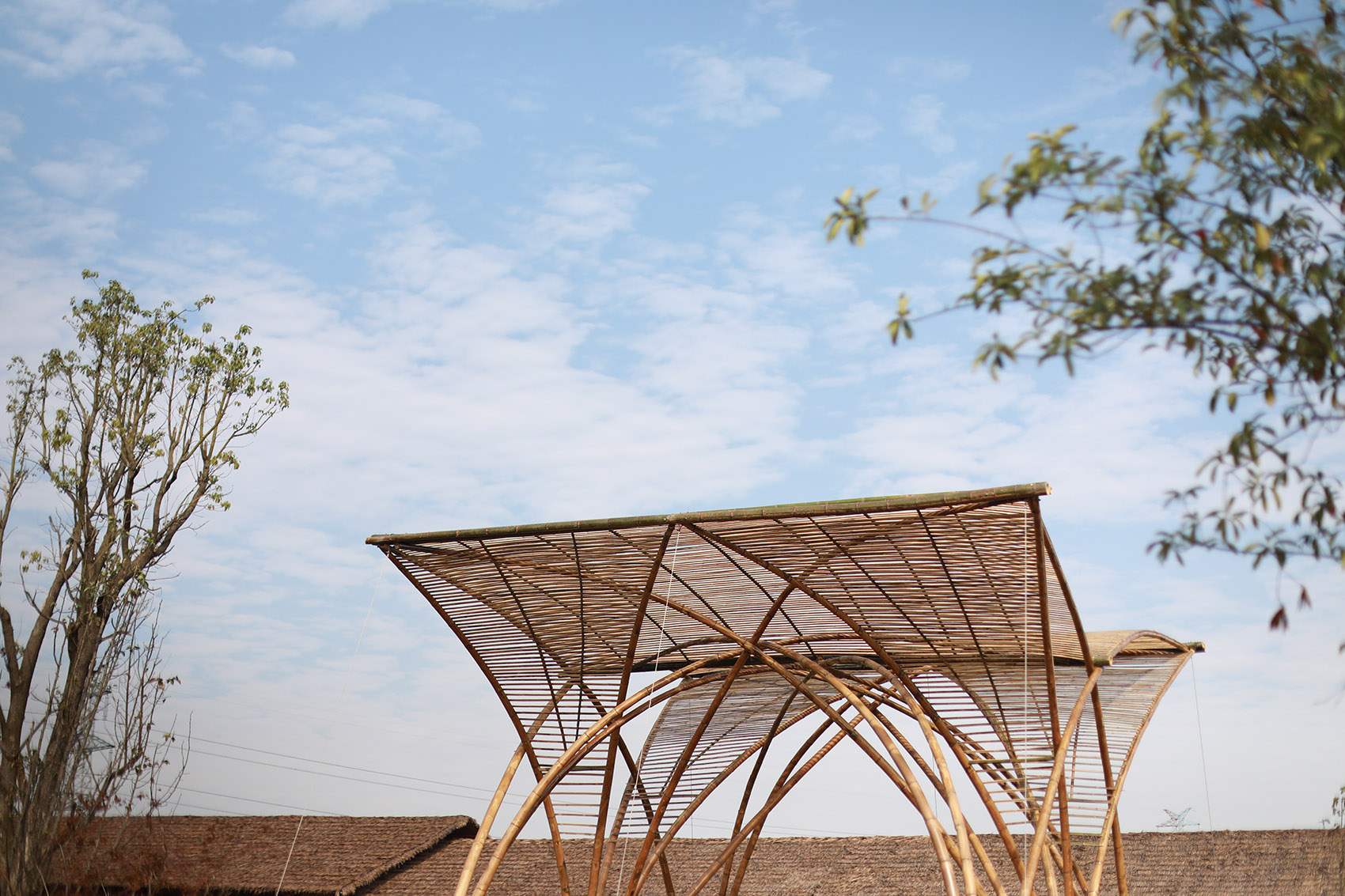
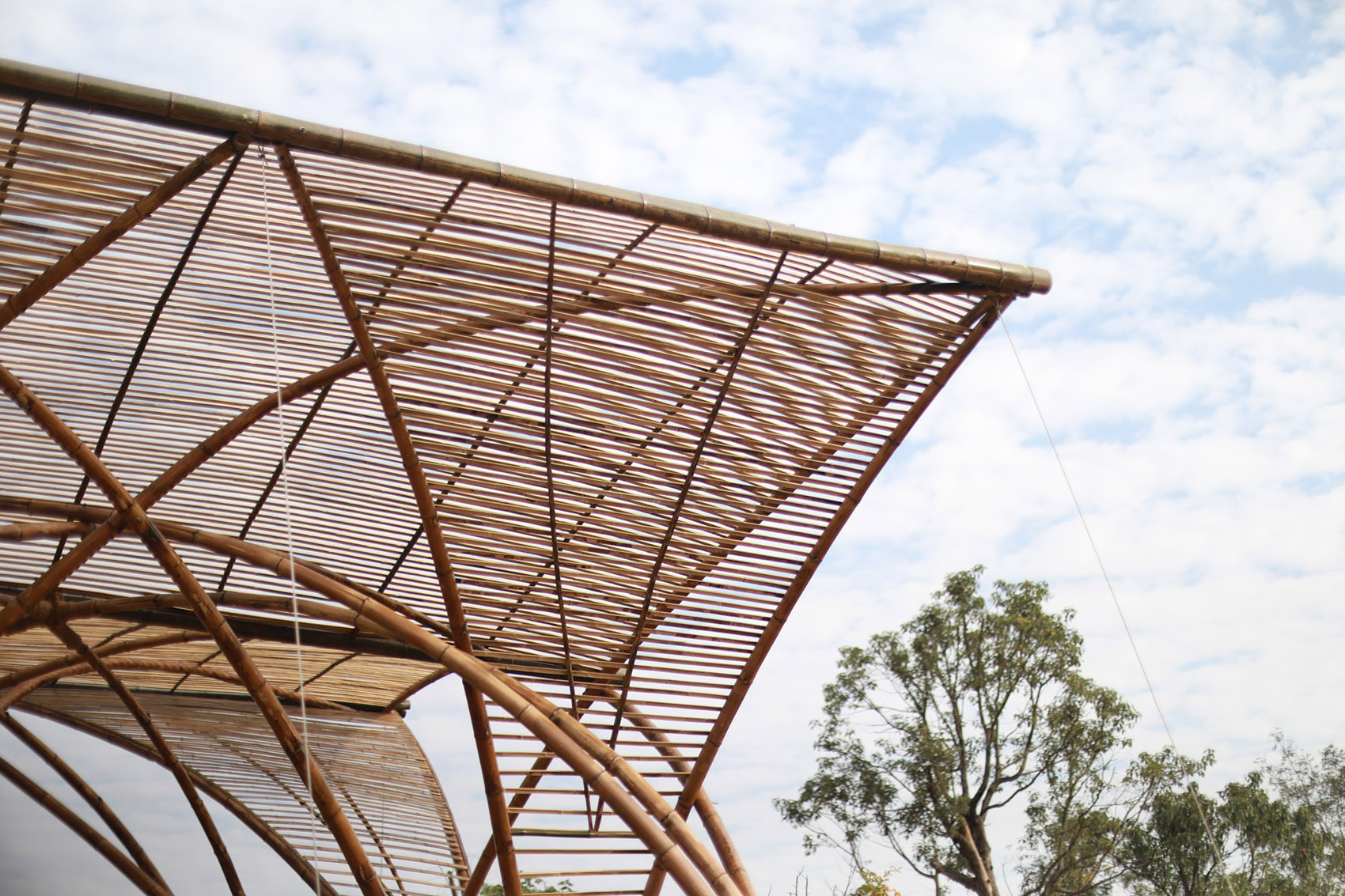
▼亭子侧面近景,closer view to the pavilion from one side ©李杨影
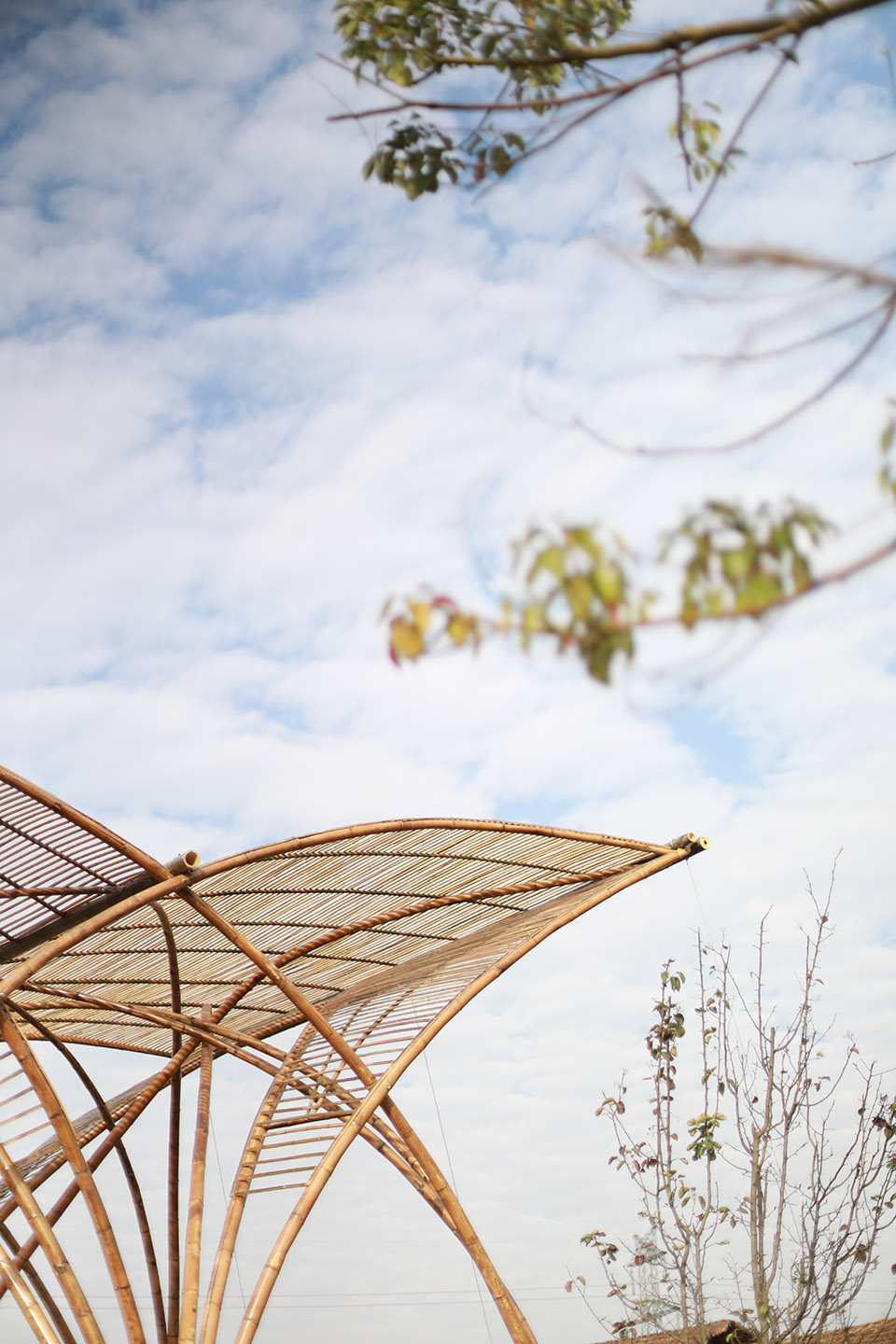
▼拱形穹窿以及四方地面为设计增添了东方神韵, The arched vaults and the square floor add oriental charm to the shape ©李杨影
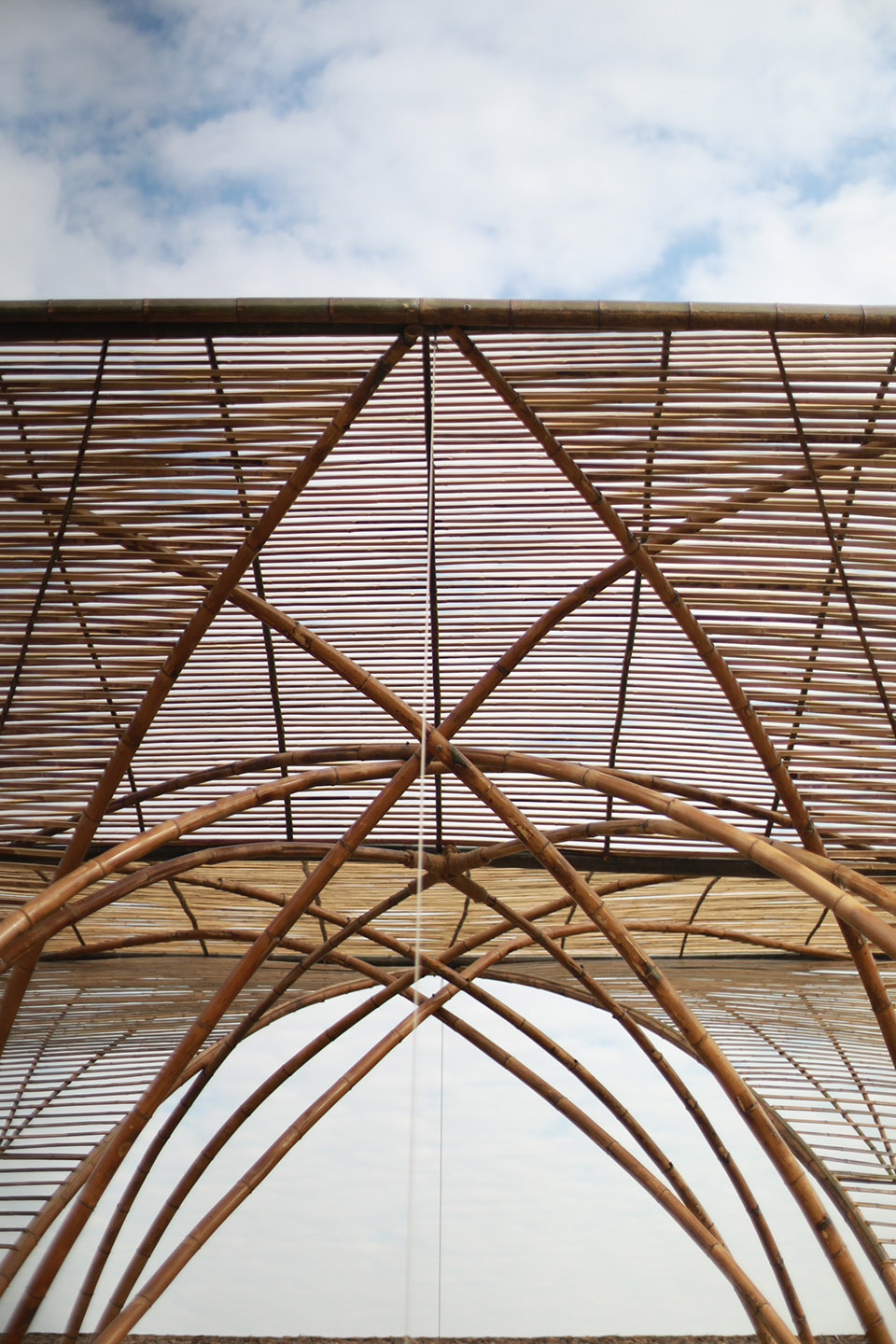
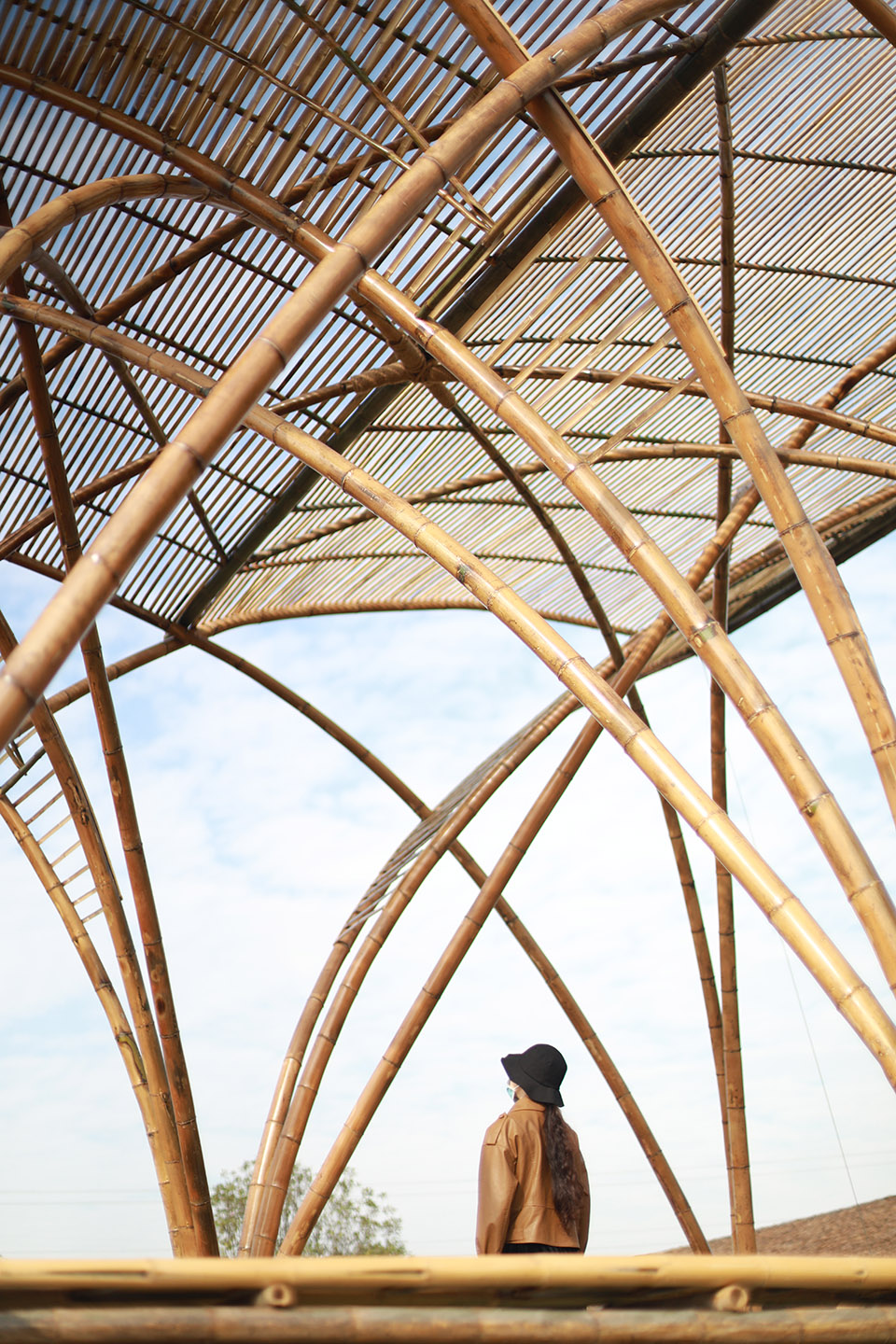
竹材选材用的是湖南楠竹。楠竹主要分布在湖南,江西,福建等地,是生长最快、材质最好、用途最多、经济价值最大、种植面积最广的竹种。楠竹竹质以湖南竹为最好。楠竹的曲度加工,我们采用热加工技术实现。竹子锚固处采用钢构件保证其连接的牢固性与耐久性,也为未来构件的单独替换成为可能,实现了建造的可持续性。结构体系采用拱结构,实现用较少的材料获得较大的跨度的可能性,同时空中弯曲的竹子营造出轻盈灵动的效果,打破了人们传统认知中竹子横平竖直的刻板印象,使结构技术和美观融为一体。
The bamboo material used is Hunan nan bamboo. Phoebe bamboo is mainly distributed in Hunan, Jiangxi, Fujian and other places. It is the bamboo species with the fastest growth, the best material, the most uses, the greatest economic value, and the largest planting area. Hunan bamboo is the best bamboo quality. We use thermal processing technology to achieve the curvature of the bamboo. The bamboo anchorage uses steel components to ensure the firmness and durability of its connection, and it also makes it possible to replace the components individually in the future, realizing the sustainability of construction. The structural system adopts an arch structure to realize the possibility of using less materials to obtain a larger span. At the same time, the curved bamboo in the air creates a light and agile effect, breaking the traditional perception of the stereotype of horizontal and vertical bamboo, making the structure Technology and beauty blend together.
分解轴测图,Exploded axonometric ©匠作工作室
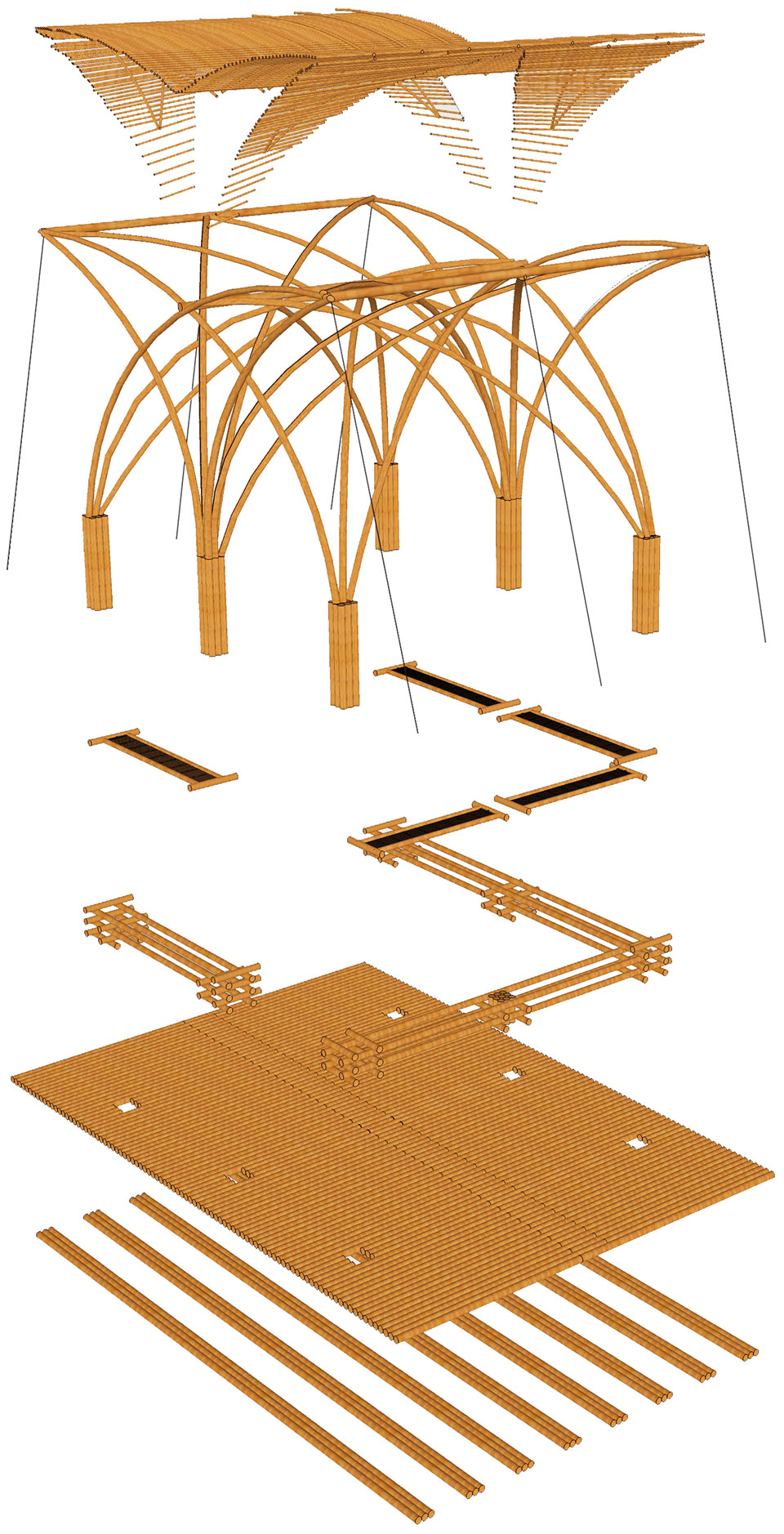
武汉夏季炎热,为满足遮阳的需求,我们劈制了竹篾覆盖顶棚,形成遮阳百叶。竹篾有意没有满铺,这样就可以透过丝丝的光,滤入剪剪的风。阳光穿过百叶洒下来柔和的光,风声穿过竹亭让人心旷神怡。轻盈朦胧的屋顶,没有阻隔自然,亭中依然能坐看云起。有足够强度的遮阳篾片,也为未来预留了盖覆轻质瓦以避雨的可能性。
Wuhan is hot in summer. In order to meet the need for shading, we split bamboo strips to cover the ceiling to form shading shutters. The bamboo strips are intentionally not full, so that they can filter in the cut wind through the light. The sun shines through the blinds and soft light, and the sound of the wind through the bamboo pavilion makes people feel refreshed. The light and hazy roof does not block nature, and you can still sit and watch the clouds in the pavilion. The sunshade sheet with sufficient strength also reserves the possibility of covering with lightweight tiles to avoid rain in the future.
▼竹篾百叶形成独特光影,Bamboo strip shutters form a unique light and shadow ©李杨影
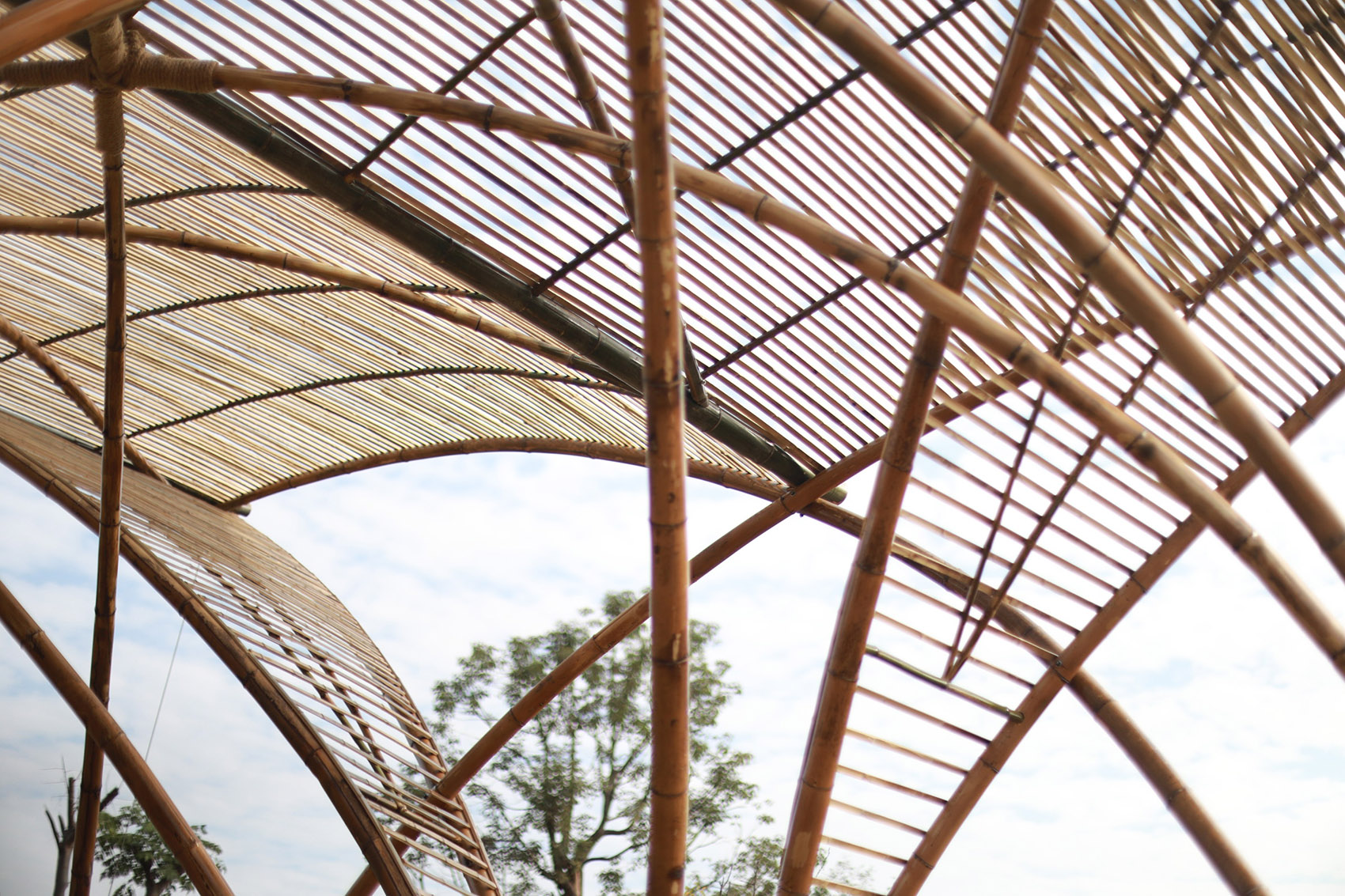
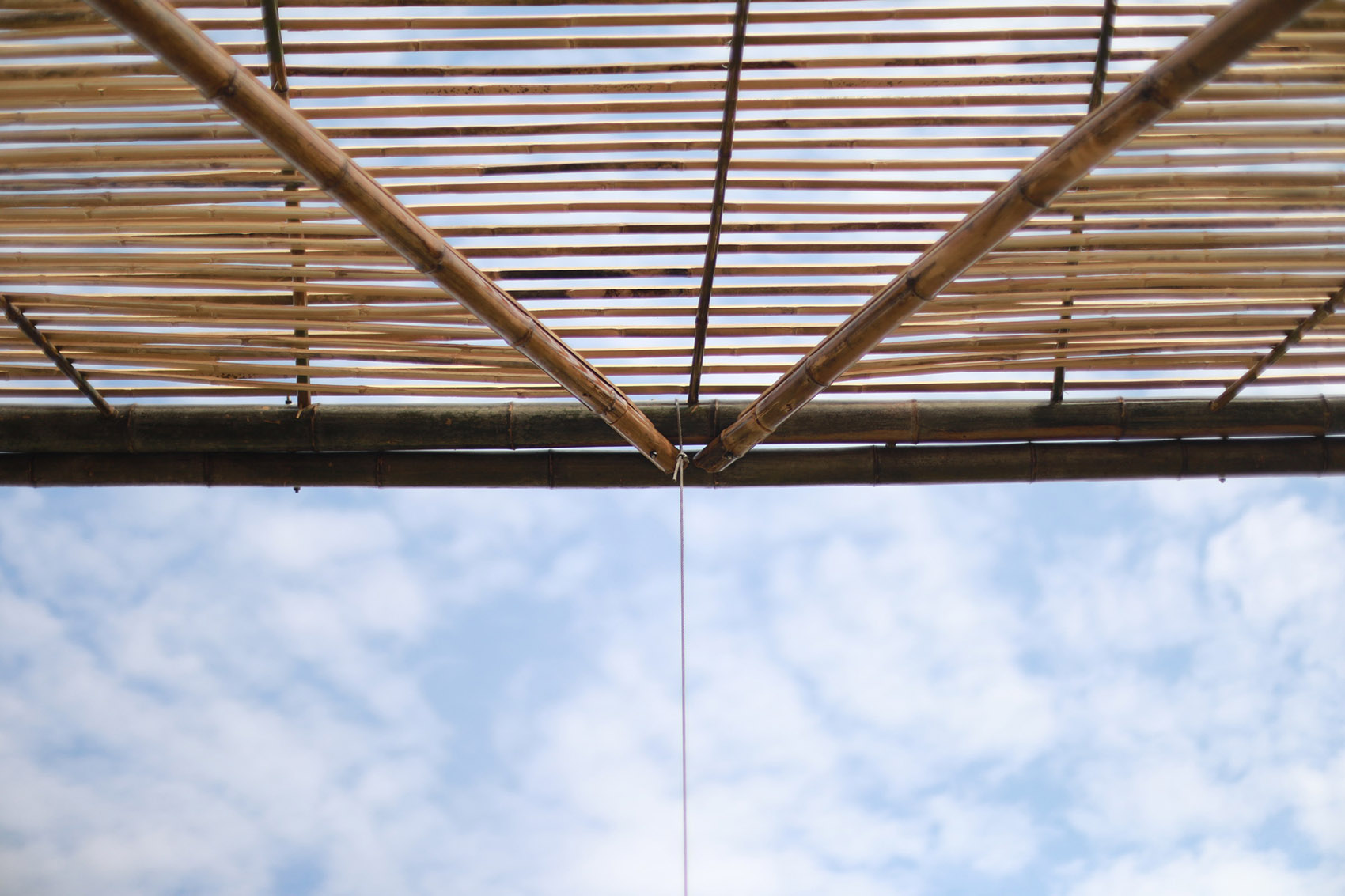
▼结点细节,Node details ©李杨影
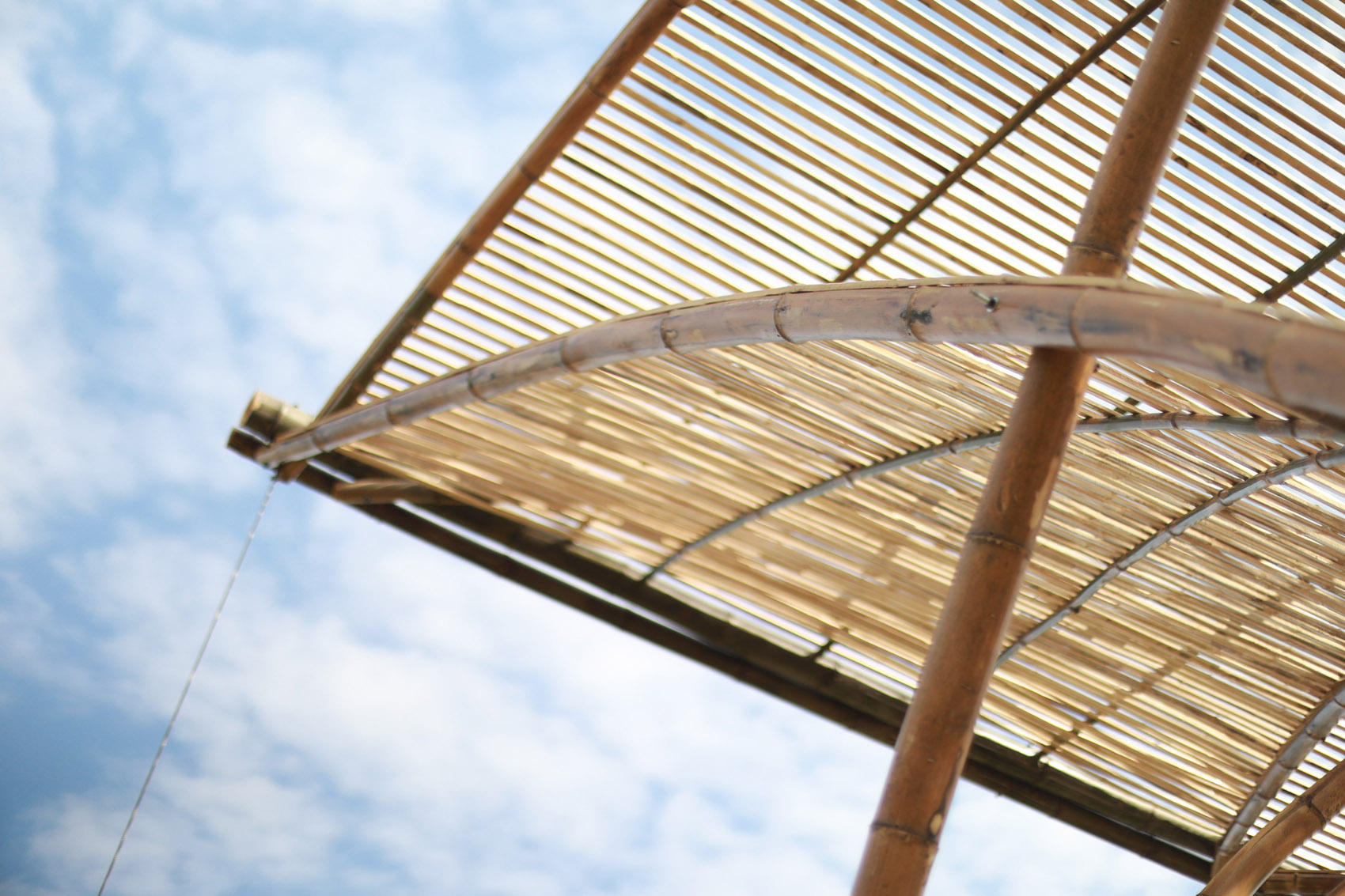
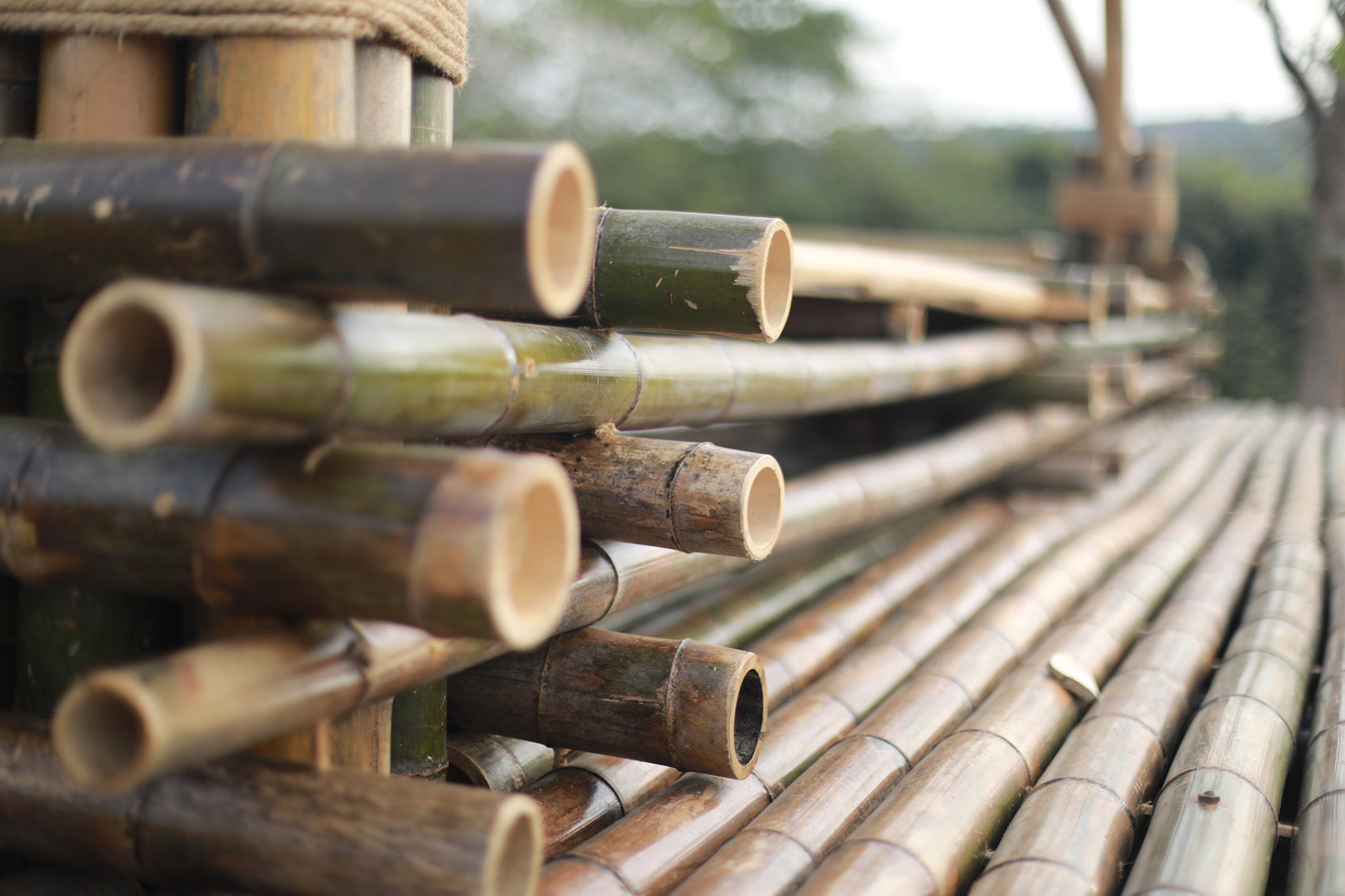
亭子有观景、停歇功用,常设在园林或名胜中,规模都较小,是一种艺术性很高的建筑物。园区希望这次的设计能容纳一个小学班级,因此采用了较大的尺度,完成的凤栖亭面宽6米,进深9米,高为5米。凤栖亭没有采用传统的亭子形象,在保留传统文化的同时,也满足现代审美趣味。传统与现代的碰撞,赋予了亭子更多的内涵,希望也以此吸引孩子们在这里能体验领会到一些传统文化和竹艺的神韵和美感。考虑能够举行多种活动的动需要,凤栖亭空间高敞开阔,结合竹基周边设置竹椅,既有围合向心的内聚性,也有向周边开敞的开放性。
The pavilion has the function of viewing and resting. It is permanently located in the garden or scenic spot. It is small in scale and is a highly artistic building. The park hopes that this design can accommodate a primary school class, so a larger scale is adopted. The finished Fengqi Pavilion is 6 meters wide, 9 meters deep, and 5 meters high. Fengqi Pavilion does not adopt the traditional image of a pavilion. While retaining traditional culture, it also satisfies the modern aesthetic taste. The collision of tradition and modernity has given the pavilion more connotation. It is hoped that this will also attract children to experience the charm and beauty of some traditional culture and bamboo art. Considering the dynamic needs of being able to hold a variety of activities, the space of Fengqi Pavilion is high and wide, combined with the bamboo chairs set around the bamboo base, which has both the cohesion of enclosing and centripetal, and the openness of opening to the periphery.
▼满足丰富的娱乐活动以及供人休息的空间,Meet the rich entertainment activities and space for people to rest ©李杨影
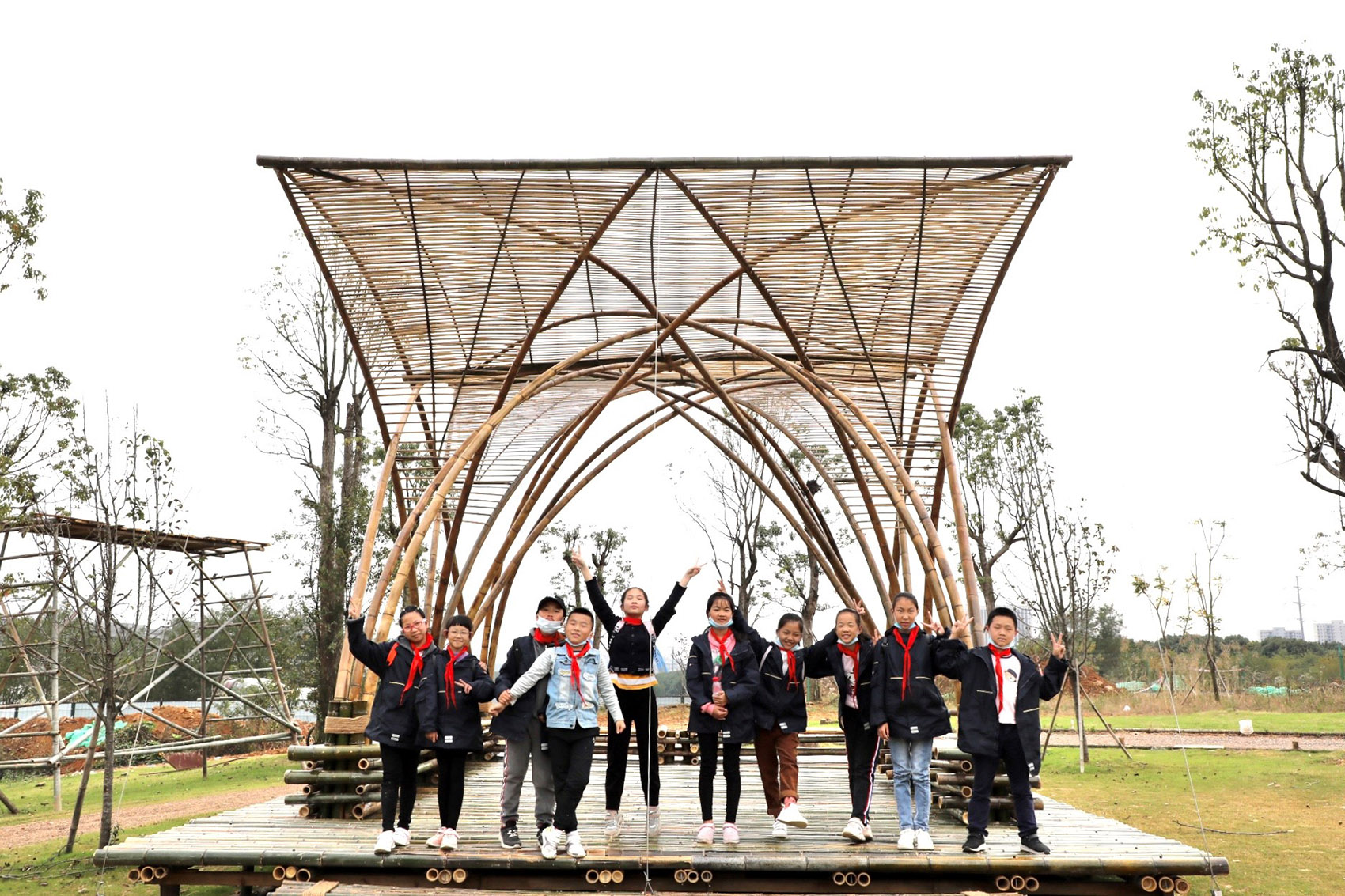
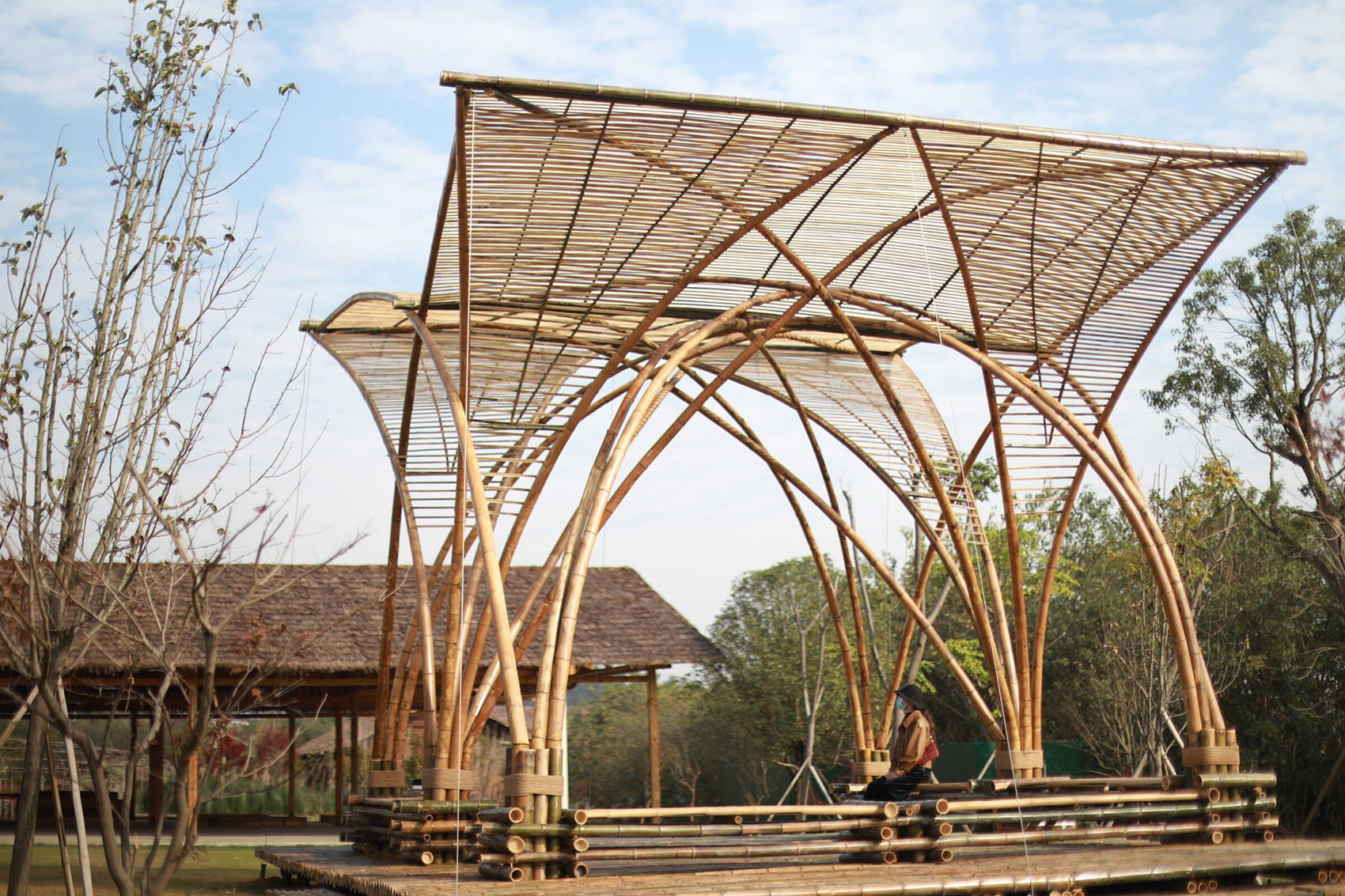
中国产竹,古人爱竹,很多竹构技艺也被完整地传承至今。然而随着竹制品逐渐淡出现代生活和文化视野,传统竹艺也面临着失传的危险。我们希望通过我们的浅显尝试,再次唤醒对传统竹艺的关注。特别感谢园区总经理熊琳晖先生对此次建造的大力支持。
Bamboo is produced in China, and the ancients loved it. Many bamboo construction techniques have been passed down to this day. However, as bamboo products gradually fade out of modern life and cultural vision, traditional bamboo art is also facing the danger of being lost. We hope that through our simple attempts, we will once again awaken our attention to traditional bamboo art. Special thanks to Mr. Xiong Linhui, general manager of the park, for his strong support for this construction.
▼建造过程,Construction process ©匠作工作室


▼总平面图,Siteplan ©匠作工作室
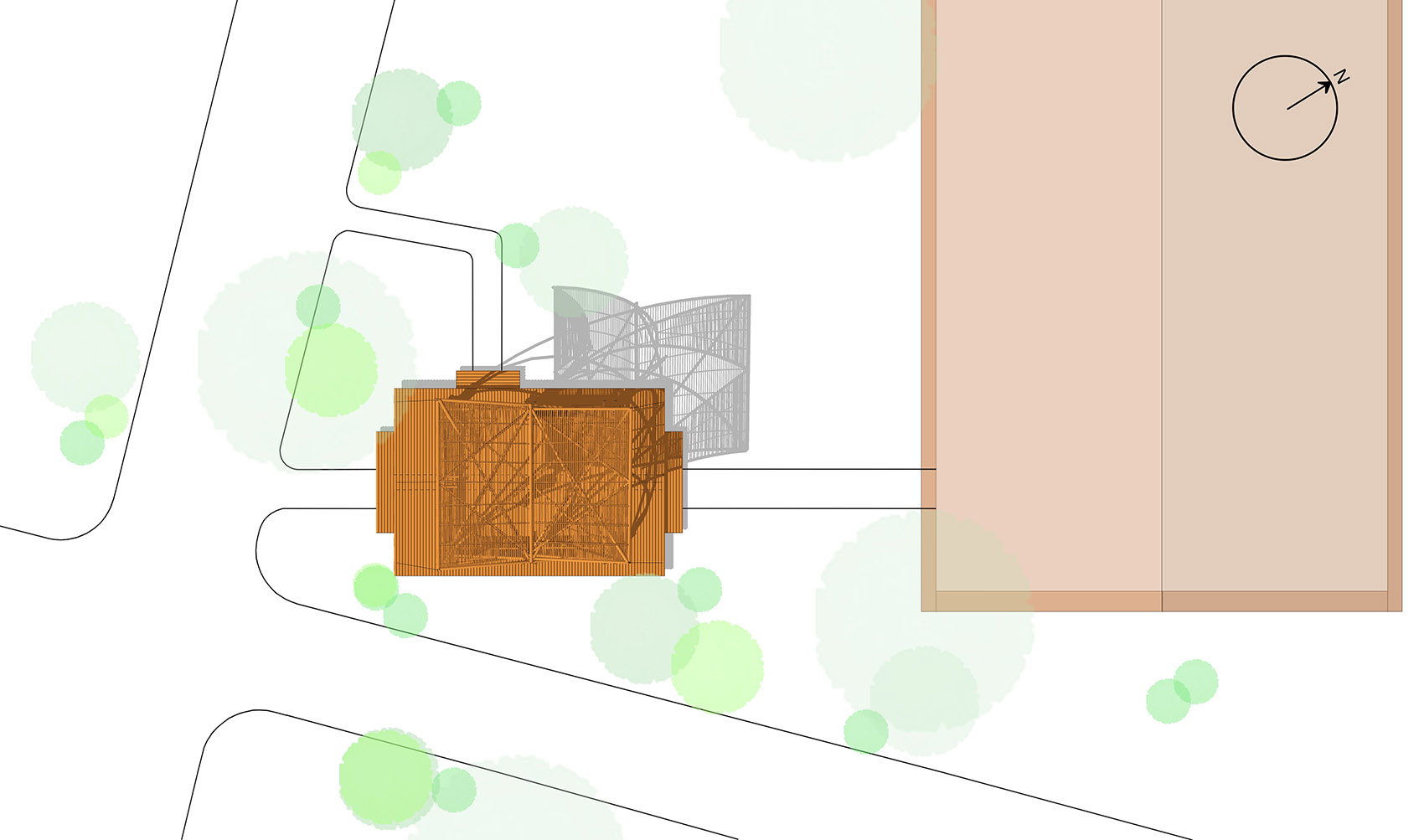
▼立面图,Elevations ©匠作工作室


